
Prepared for Agriculture and Agri-Food Canada
Supplier: Leger Marketing Inc.
Contract Number: 01B68-210085/001/CY
Contract Value: $99,471.08 (including HST)
Award Date: 2021-12-09
Delivery Date: March 21, 2022
Registration Number: POR 063-21
For more information on this report, please contact Agriculture and Agri-Food Canada at aafc.info.aac@agr.gc.ca Canadian Agricultural Partnership.
Ce rapport est aussi disponible en français
Prepared for Agriculture and Agri-Food Canada
Supplier name: Leger Marketing Inc.
Date: March 21, 2022
This public opinion research report presents the results of an online survey conducted by Léger Marketing Inc.on behalf of Agriculture and Agri-food Canada. The quantitative research study was conducted between January and March 2021.
This publication may be reproduced for non-commercial purposes only. Prior written permission must be obtained from Agriculture and Agri-food Canada. For more information on this report, please contact: aafc.info.aac@agr.gc.ca.
Agriculture and Agri-Food Canada
1341 Baseline Road
Ottawa, ON K1A 0C5
Catalogue Number: A22-623/3-2022E-PDF
International Standard Book Number (ISBN): 978-0-660-42820-8
Agriculture and Agri-Food Canada Number: 13114E
Related publications registration number: POR 063-21
Cette publication est aussi disponible en français sous le titre: Sondage 2021-2022 sur les enjeux stratégiques des producteurs (Vague VII) - Rapport final.
ISBN: 978-0-660-42822-2
©Her Majesty the Queen in Right of Canada, as represented by the Minister of Agriculture and Agri-Food Canada, 2022.
Leger Marketing Inc. (Leger) is pleased to present this report to Agriculture and Agri-food Canada (AAFC) on the findings from the seventh wave of the Strategic Issues Survey with Producers, designed to learn about Canadian farmers and the challenges they face.
AAFC has been conducting the Strategic Issues Survey, a survey of producers, since 2007. The research is designed to provide insight into the views of producers on current agricultural issues in Canada and on priorities and policies that affect the agriculture and agri-food sector.
The survey builds on tracking questions from previous waves to note trends over time but also provides insights on new and evolving areas of interest to AAFC. This wave of research includes a focus on sustainability, along with other upcoming priorities. This year’s research also continues to track benchmarks of the department’s multi-year agricultural policy framework, the Canadian Agricultural Partnership. The contract value for this project was $99,471.08 including HST.
Specific objectives of the research include, but are not limited to, providing AAFC with up-to-date data on:
Intended use of the research
The findings of the research will be used in the development of policies, programs and initiatives, to improve communications and to better serve clients. The results are used to gain critical insights on the opinions, issues and challenges facing agricultural producers in Canada.
This public opinion research was conducted via telephone survey, using Computer Aided Telephone Interviewing (CATI) technology. Fieldwork for the survey was carried out from January 18 to March 3, 2022. A total of 1,447 Canadian producers aged 18 or older were surveyed. To be eligible, respondents had to be at least 18 years old, live in Canada, be at least a joint decision-maker of their farming operation and have more than $10,000 in farm sales in 2021. The average length of interview was 27 minutes and 42 seconds. Contacting was done through a phone list including individuals working in the agriculture industry. The overall response rate for the survey was 38%. Considering a total population size of 373,940 agricultural producers in Canada, the margin of error for a 1,447 producers’ sample is ±2.6%, 19 times out of 20.
Weighting was done following the same structure as previous waves, by revenue and region to help readjust the sample for minor imbalances. However, some subgroups still has insufficient sizes to draw any significant observations.
Leger adheres to the most stringent guidelines for quantitative research. The survey instrument was compliant with the Standards of Conduct of Government of Canada Public Opinion Research.
A complete methodological description is provided in the Appendices section of this document.
Sample overview
Around half (47%) of producers that were surveyed generated incomes lower than $100,000, and a third (34%) generated over $250,000, similar to the 2018 study. A third of farms are oilseed and grain farming operations (32%), and another one in four are cattle ranching and farming operations (24%). Compared to 2018, this wave of the study includes slightly fewer dairy cattle and milk production operations (9% versus 11%) and poultry farming operations (2% versus 4%), and more vegetable farming operations (8% versus 5%).
General challenges and practices
While over a third (36%) of producers were optimistic about the future of their farm operation saying they expect to be a little better (27%) or much better off (9%) in five years, more than one in four (28%) feel they will be a little worse (17%) or much worse (11%) off. Close to a third (30%) do not expect any changes (positive or negative) to their operation in the next five years, similar to the 2018 wave.
The most important issues facing Canadian agriculture over the next five years is production/input costs (28%, up significantly from 13% in 2018) followed by climate change impacts, including extreme weather and natural disasters (21%, up from 11% in 2018).
However, climate change impacts are still the main business risk producers are facing (52%), consistent with previous waves. A significantly greater proportion of producers are also facing increased production and input costs (up 7% from 2018) this year.
Around a third (35%) of agricultural producers declared having an emergency plan put in place, but almost all of them have implemented one or more measures to mitigate the risks their farm might face in the future. Financial planning (72%) and environment and/or sustainable measures (71%) were at the top of the list with more than seven farms out of ten putting these measures in place. In comparison with 2018, a higher proportion of producers have implemented biosecurity measures (40% versus 36%), stockpiled supplies (54% versus 43%), emergency kits (59% versus 49%) and environment and/or sustainability measures (71% versus 62%).
Diversification of farm products to face economic uncertainties was considered important by nine out of ten (87%) agricultural producers but only one in two producers (53%) said they did diversify their markets as a way to manage emergency risks.
While technology might provide some solutions regarding the various challenges farmers have to face, its adoption is mitigated by various barriers. Cost was rated as the largest barrier (73% rated it as an extreme or moderate barrier), along with level of risk for the return on investment (64%), lack of time to learn about (45%) and implement (48%) the innovations. The lack of access to high speed internet/cellular service was a barrier for 38% of producers. Although, almost a quarter (22%) of producers responded internet accessibility was an extreme barrier. This extreme barrier result ranked third just behind cost (44%) and the level of risk for the return on investment (26%). To counter these, farmers want financial assistance (64%), and general training on technologies to be able to see their benefits in action (opportunity to see technology in action: 59%, technical advice: 55%, more information: 52%).
Public trust
Virtually all producers (99%) have implemented at least one trust-building measure on their farm. Environment stewardship programs (67%) and nutrient management plans (67%), along with reduced pesticide use (66%) were the most common measures put in place.
Public perceptions play a strong role in how producers make decisions about their farm operations, as they might impact demand levels: six out of ten (59%) producers considered that public perceptions play a moderate to very strong role in their decision making, while only one in ten (14%) said they have no impact at all. The proportion of producers who considered public perceptions to have an impact on their farm operation is lower in 2022 compared to 2018 (59% vs 66%).
Environmental initiatives (93%), along with food safety (92%), were deemed the two most important elements that play a part in building and maintaining the public's trust in the agricultural sector. To that effect, around half (47%) of producers had a formally written environmental farm plan. Producers from Quebec and the Atlantic region seemed significantly more aware of environmental challenges and initiatives, as they were more likely to consider environmental management important to build and maintain the public’s trust than their counterparts from other provinces (96% and 98% respectively, versus 92% overall).
Environment and sustainability
Producers considered that their agricultural activities have a positive impact on the environment (69%) rather than a negative one (15%), and almost three out of four of them (73%) felt that agricultural producers take the appropriate actions to minimize the impact of their operations on the environment. Furthermore, half (50%) of them gave sustainability initiatives a high priority while only one in ten (9%) producers gave them a low priority.
Although not all farms have an environmental plan in place (around half of them, 47%, do), most have implemented at least one environmental measure, if not more (98%). Reduced pesticide use (74%), crop rotations (74%), and water quality and quantity improvements (67%) were the most popular measures put in place by agricultural producers.
Overall, one producer out of ten (9%) is organic certified, but this proportion almost tripled when it came to poultry (20%), vegetable (24%), and fruit farming operations (21%).
Labour market challenges
Around a third (35%) of producers were facing labour market challenges in 2022. The pandemic along with the massive quitting of workers that ensued (The Great Resignation) might have exacerbated labour market challenges for farm producers as well. Recruiting staff was a problem for over eight out of ten (84%) producers who faced labour market challenges. Recruiting issues pertained mainly to hiring high skilled (39%) or low skilled (50%) workers. On farm experience (18%) and experience operating farming equipment and heavy machinery (16%) were two of the main skills that were hard to come across.
Relationship with AAFC and their programs
Around a third (34%) of farm operators were aware of the Canadian Agricultural Partnership. The proportion was higher among producers from Alberta (40%). Overall, the impressions of the Partnership were mostly positive (59% versus 15% negative). Both awareness and positive impressions have seen a significant increase since 2018 (up by 6% and 10% respectively), but this increase has not translated into familiarity with the Canadian Agriculture Partnership and AAFC programs offered: six in ten producers (59%) did not have top of mind (unaided awareness) of AAFC programs.
While familiarity may be low, producers still considered the Canadian Agricultural Partnership's investments important. According to them, the main priorities the Government of Canada should support were advancing agriculture science and research (92%) and promoting trade and increasing agricultural exports (87%). Supporting mental health initiatives (85%) and addressing environmental climate change (78%), as well as supporting diversity in the industry (72%) have gained importance to producers since 2018.
Focus on young and female producers
Younger producers (who are aged 18 to 34 years old) and female producers were more optimistic towards the future of their farm operation (53% and 42% versus 36% overall). Being more concerned about environmental challenges, they highly prioritized sustainability (18-34: 59%, women: 57% versus 50% overall). This heightened attention to sustainability also explains why they were more likely to think agricultural activities have a positive impact on the environment (79% and 73% respectively versus 69% overall).
Young producers were more likely to have implemented an emergency management plan (46% versus 34% among older producers), report needing financial assistance (77% versus 59% among 55+) to overcome barriers to technological innovation and were more likely to have faced labour market challenges (57% versus 35% overall).
Female producers were more likely to think environmental management (96% versus 91%), animal welfare (92% versus 83%), food safety (96% versus 91%), and labour practices (88% versus 82%) are important to build and maintain the public's trust. Female producers have more barriers to adopting new technologies than men. Female producers also faced more barriers to adopting new technologies than men.
The views and observations expressed in this document do not reflect those of AAFC. This report was compiled by Leger based on the research conducted specifically for this project.
Respondents for this survey were selected from a list of individuals working in the agricultural industry. Since the telephone list the sample was drawn from is exhaustive, results can be statistically projectable to the target population (Canadian producers). The data have been weighted to reflect the demographic composition of the target population.
Political neutrality statement and contact information
Research Firm:
Leger Marketing Inc. (Leger)
Contract Number: 01B68-210085/001/CY
Contract award date: 2021-12-09
Leger Marketing Inc. hereby certifies that the deliverables fully comply with the Government of Canada political neutrality requirements outlined in the Policy on Communications and Federal Identity and the Directive on the Management of Communications. Specifically, the deliverables do not include information on electoral voting intentions, political party preferences, standings with the electorate, or ratings of the performance of a political party or its leaders.

Signed:
Christian Bourque
Senior Researcher, Léger
Date: March 21, 2022
AAFC has been conducting the Strategic Issues Survey, a survey of producers, since 2007. The research is designed to provide insight into the views of producers on current agricultural issues in Canada and on priorities and policies that affect the agriculture and agri-food sector. The survey builds on tracking questions from previous waves to note trends over time but also provides insights on new and evolving areas of interest to AAFC.
Specific objectives of the research include, but are not limited to, providing AAFC with up-to-date data on:
This public opinion research was conducted via telephone survey, using Computer Aided Telephone Interviewing (CATI) technology. Fieldwork for the survey was carried out from January 18 to March 3, 2022. A total of 1,447 Canadian producers aged 18 or older were surveyed.
The detailed results section presents only the significant differences between 2022 and 2018, regions, production types, gender, and age. For further details on the methodology, refer to appendix A.1.
Note: Numbers were rounded, totals may not always equal 100%.
Overall, the farming profile is very similar to previous waves. Almost half of producers (42%) have more than forty years of farm management experience. Fewer (34%) had between twenty and forty years of experience while just under one in four (23%) had less than twenty years of farm management experience. Compared to 2018, more producers had between five and nine years of management experience (8%, up by 3% from 2018), between ten and fourteen years of management experience (4%, up by 3% from 2018) or between fifty and fifty-four years of management experience (12%, up by 5% from 2018).
Off Farm Income
In 2022, half of producers (51%) have off-farm income similar to 2018.
| Measure | Response | Total 2022 (n=1,447) |
Total 2018 (n=1,504) |
Statistically significant difference between years (Y) |
|---|---|---|---|---|
| Years of farm management experience | Less than five years | 3% | 2% | |
| 5-9 years | 8% | 5% | Y | |
| 10-14 years | 7% | 4% | Y | |
| 15 to 19 years | 5% | 6% | ||
| 20-24 years | 8% | 10% | ||
| 25-29 years | 7% | 7% | ||
| 30-34 years | 11% | 16% | Y | |
| 35-39 years | 8% | 13% | Y | |
| 40- 44 years | 14% | 17% | Y | |
| 45-49 years | 9% | 8% | ||
| 50-54 years | 12% | 7% | Y | |
| 55-59 years | 3% | 3% | ||
| 60-64 years | 3% | 2% | ||
| 65 years or more | 1% | 1% | ||
| Off farm income | Yes | 51% | 50% | |
| No | 49% | 49% | ||
| Farm revenue | $10,000 to just under $25,000 | 15% | 13% | |
| $25,000 to just under $50,000 | 17% | 19% | ||
| $50,000 to just under $100,000 | 15% | 15% | ||
| $100,000 to just under $150,000 | 9% | 8% | ||
| $150,000 to just under $200,000 | 4% | 6% | Y | |
| $200,000 to just under $250,000 | 6% | 5% | ||
| $250,000 to just under $500,000 | 14% | 14% | ||
| $500,000 or more | 20% | 20% | ||
| Main type of production | Oilseed and grain farming | 30% | 35% | |
| Cattle ranching and farming | 24% | 27% | ||
| Dairy cattle and milk production | 9% | 11% | Y | |
| Vegetable farming | 8% | 5% | Y | |
| Fruit farming | 5% | 5% | ||
| Forage | 3% | 2% | ||
| Beekeeping | 2% | 2% | ||
| Poultry farming | 2% | 4% | Y | |
| Pig farming | 2% | 1% | ||
| Greenhouse, nursery and plant production | 2% | no data | ||
| Flower farming | 1% | no data | ||
| Lamb & sheep production | 2% | no data | ||
| Other types of farm production | 7% | 7% |
Results show that around a third (32%) of farms generated between $10,000 and $50,000 of revenues, another third generated between $50,000 and $250,000 (34%), and a final third generated over $250,000 of revenue (34%). Around one in five (20%) producers stated that their farm operation generates over $500,000 of yearly revenue. As data has been weighed using data from the 2016 Canadian census of agriculture, no significant differences can be drawn with the 2018 study.
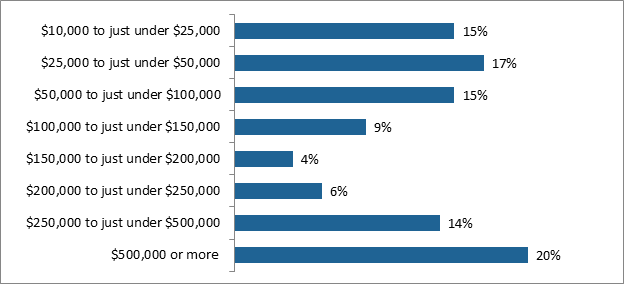
Q2: For classification purposes, what were your total farm sales last year, that is, in 2021? Total sales excluding any taxes they collected from customers (GST/PST/HST).Base: All respondents (n=1,447)
| Total farm sales | Total |
|---|---|
| $10,000 to just under $25,000 | 15% |
| $25,000 to just under $50,000 | 17% |
| $50,000 to just under $100,000 | 15% |
| $100,000 to just under $150,000 | 9% |
| $150,000 to just under $200,000 | 4% |
| $200,000 to just under $250,000 | 6% |
| $250,000 to just under $500,000 | 14% |
| $500,000 or more | 20% |
Significant subgroup differences regarding total farm sales include:
Around one in three (32%) producers run oilseed and grain farming operations, and one in four (24%) are cattle ranching and farming operations. Dairy cattle and milk production operations (9%), vegetable farming (8%), and fruit farming (5%) complete the top five of production types in the sample. Around one in ten (7%) farmers have other types of farm production. While grain farming operations make up the majority of surveyed producers since 2011, their proportion has been consistently falling, going from 41% in 2017 to 35% in 2018 to 32% in 2022. Significant differences with the 2018 study include:
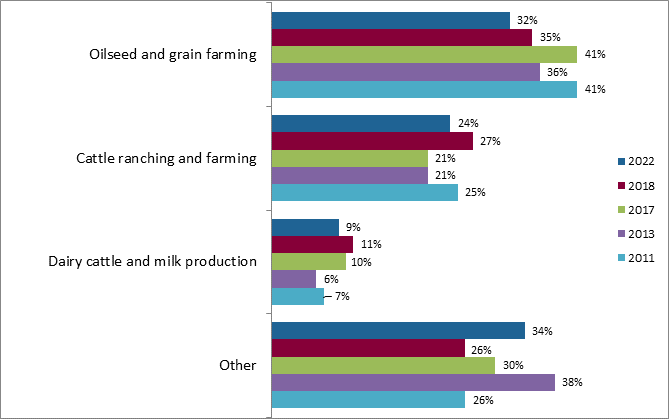
Q7: In 2021, what type of production contributed most to your gross farm revenue? Base: All respondents (n=1,447)
| 2022 | 2018 | 2017 | 2013 | 2011 | |
|---|---|---|---|---|---|
| Oilseed and grain farming | 32% | 35% | 41% | 36% | 41% |
| Cattle ranching and farming | 24% | 27% | 21% | 21% | 25% |
| Dairy cattle and milk production | 9% | 11% | 10% | 6% | 7% |
| Other | 34% | 26% | 30% | 38% | 26% |
Note: Detailed farm operation types are presented in the demographic profile table.
Significant differences among subgroups regarding production types include:
Over one in four (28%, up 15% since 2018) producers considered production and input costs to be the most important issue facing Canadian agriculture over the next five years, followed by climate change and its impacts (21%, up 10% since 2018), and labour shortages (8%, up 3% since 2018). The next tier of responses, ranging from 3% to 5% are government intervention (5%), commodity prices (4%), and profitability (4%).
Compared to 2018, production/input costs and climate change are bigger issues in 2022 (28% versus 13% and 21% versus 11% respectively). Conversely, commodity prices and international trade barriers were seen as bigger challenges in 2018 compared to 2022 (11% versus 4% and 16% versus 3% respectively).
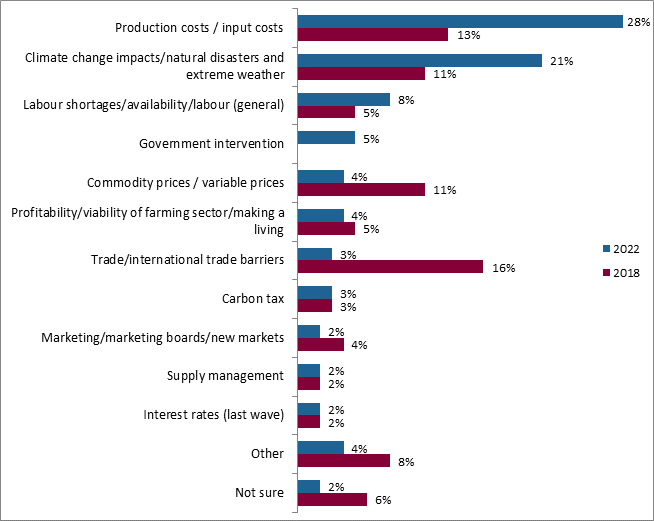
Q8: Looking ahead, what do you think will be the single most important issue facing Canadian agriculture over the next 5 years? Base: All respondents (n=1,447)
| 2022 | 2018 | |
|---|---|---|
| Production costs / input costs | 28% | 13% |
| Climate change impacts/natural disasters and extreme weather | 21% | 11% |
| Labour shortages/availability/labour (general) | 8% | 5% |
| Government intervention | 5% | no data |
| Commodity prices / variable prices | 4% | 11% |
| Profitability/viability of farming sector/making a living | 4% | 5% |
| Trade/international trade barriers | 3% | 16% |
| Carbon tax | 3% | 3% |
| Marketing/marketing boards/new markets | 2% | 4% |
| Supply management | 2% | 2% |
| Interest rates (last wave) | 2% | 2% |
| Other | 4% | 8% |
| Not sure | 2% | 6% |
Significant differences regarding agricultural challenges in the future include:
Producers were divided in their views about their future performance. Over a third (36%) of producers considered that their future situation will be better than now, while over a quarter (28%) thought it will be worse. Another third (30%) do not expect much change in their situation in the next five years. The proportion of producers who feel optimistic about the future of their farm operation has been constant since 2017 (35% in 2018 and 39% in 2017), when it dropped significantly from its 2013 level (48%).
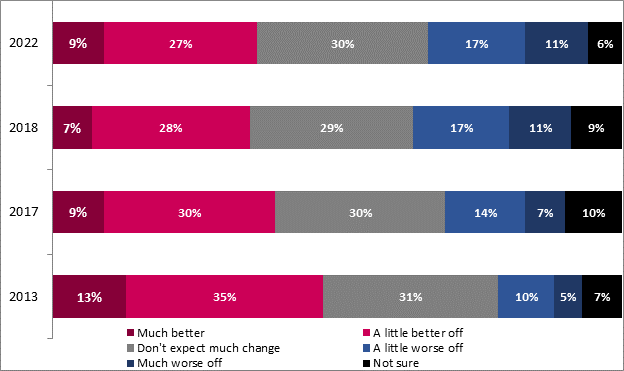
Q9: Looking ahead, how much better or worse off will your farm operation be in five years, compared to how it is now? Base: All respondents (n=1,447)
| Much better | A little better off | Don't expect much change | A little worse off | Much worse off | Not sure | |
|---|---|---|---|---|---|---|
| 2022 | 9% | 27% | 30% | 17% | 11% | 6% |
| 2018 | 7% | 28% | 29% | 17% | 11% | 9% |
| 2017 | 9% | 30% | 30% | 14% | 7% | 10% |
| 2013 | 13% | 35% | 31% | 10% | 5% | 7% |
The following subgroups were more likely to think their farm operation will be better off in five years:
The main business risk that agricultural producers were facing was climate change and its impacts, as it was mentioned by more then half of them (52%). The increase of operational, production and input costs was the second most preoccupying issue (35%), followed by market price fluctuations (20%). Diseases or pests (12%), fewer farm families and succession issues (10%) and economic trends/interest rates/inflation (10%) were also faced by one producer out of ten.
The following business risks were more important in 2022 compared to 2018:

Q10: What type of business risks does your farming operation face? Base: All respondents (n=1,447)
*Respondents were able to give up to three answers, total mentions may exceed 100%.
| 2022 | 2018 | 2017 | 2013 | |
|---|---|---|---|---|
| Climate change impacts/natural disasters and extreme weather | 52% | 47% | 48% | 52% |
| Increased operational/production/input costs | 35% | 23% | 27% | 34% |
| Market price fluctuations/volatility | 20% | 36% | 34% | 29% |
| Diseases or pests (e.g. mad cow, crop blight) | 12% | 15% | 20% | 24% |
| Fewer farm families/succession issues | 10% | 1% | no data | no data |
| Trade barriers/Barriers to market access | 6% | 15% | 11% | 1% |
| Changing government policies and programs | 6% | 10% | 9% | 5% |
| Profitability/Viability of Farming Sector/Making a Living | 5% | 2% | no data | no data |
| Weather/weather conditions (general) | 5% | 0% | no data | no data |
| Taxes/Carbon Tax | 4% | 1% | no data | no data |
| Interest rates | 4% | 3% | no data | no data |
| Increasing competition | 4% | 1% | no data | no data |
| Transportation or logistical challenges | 3% | 2% | no data | no data |
| Exchange rates/fluctuations in the dollar | 3% | 4% | 5% | 3% |
| Economic trends / economy / inflation | 3% | 0% | no data | no data |
| Other international factors | 2% | 4% | 3% | 6% |
| Supply chain management | 2% | 1% | no data | no data |
| Cyber Risks | 2% | 0% | no data | no data |
| Other | 7% | 6% | no data | no data |
| Not sure (VOLUNTEERED) | 4% | 4% | 2% | 3% |
The following subgroups were more likely to face some specific risks:
Producers all seemed ready to face business emergencies if they arose, as almost all (97%) have put in place at least one action to manage emergency risks. The most popular measures taken were financial planning and environment/sustainability measures (72% and 71% respectively), followed by having an emergency kit (59%). Over half of producers have put in place the following measures: a traceability system (56%), animal welfare measures (55%), stockpiled supplies (54%), and diversification of farm products (53%). Producers have implemented 7.1 measures on average.
As answer options were not exactly the same, comparison with the 2018 wave is presented for information purposes only. Since 2018, there is a significant increase of producers who have implemented:
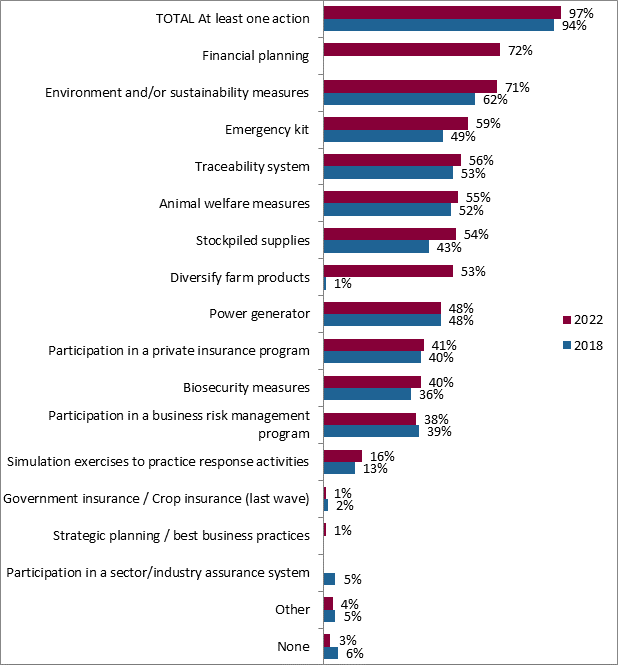
Q12: What, if any, actions have you taken to manage or plan for the emergency risks that your farm operation may face? Have you implemented... Base: All respondents (n=1,447)
*Respondents were able to give up to three answers, total mentions may exceed 100%.
| 2022 | 2018 | |
|---|---|---|
| TOTAL At least one action | 97% | 94% |
| Financial planning | 72% | no data |
| Environment and/or sustainability measures | 71% | 62% |
| Emergency kit | 59% | 49% |
| Traceability system | 56% | 53% |
| Animal welfare measures | 55% | 52% |
| Stockpiled supplies | 54% | 43% |
| Diversify farm products | 53% | 1% |
| Power generator | 48% | 48% |
| Participation in a private insurance program | 41% | 40% |
| Biosecurity measures | 40% | 36% |
| Participation in a business risk management program | 38% | 39% |
| Simulation exercises to practice response activities | 16% | 13% |
| Government insurance / Crop insurance (last wave) | 1% | 2% |
| Strategic planning / best business practices | 1% | 0% |
| Participation in a sector/industry assurance system | no data | 5% |
| Other | 4% | 5% |
| None | 3% | 6% |
The following subgroups were more likely to implement some specific measures:
While various actions and measures have been put in place to mitigate the business risks that producers may face in the next few years, only a third of producers stated that they have an emergency management plan in place (35%), with 4% in the process of making one. Young producers were more likely to have implemented an emergency management plan (46% versus 34% among older producers). No significant evolution has been recorded since 2018.

Q13: Do you have an Emergency Management Plan in place for your farm operation? Base: All respondents (n=1,447)
| 2022 | 2018 | |
|---|---|---|
| Yes | 35% | 33% |
| No | 60% | 61% |
| No, but are in the process of making one | 4% | 4% |
| Prefer not to say | 1% | 1% |
A vast majority of producers considered the diversification of markets important for the growth of the Canadian agricultural sector (87%), and over half of them (59%) considered it very important, which seems in line with the proportion of producers who have diversified their farming products. On the other hand, around one in ten producers (12%) did not consider it important. There is no significant difference with 2018 in terms of perceived importance of market diversification (net important: 87% and 85% in 2022 and 2018 respectively).
Vegetable farming operations (93%) were more likely to believe that the diversification of markets is important for the growth of the Canadian agricultural sector.
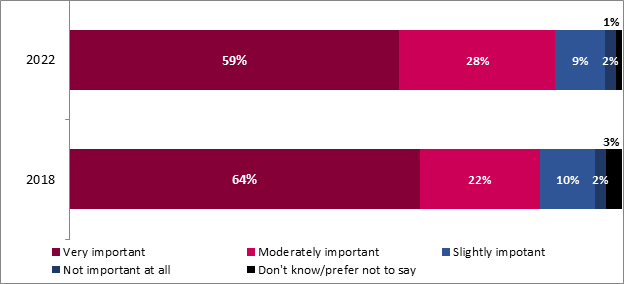
Q24: How important, if at all, do you feel diversification of markets is for the growth of the Canadian agricultural sector? Base: All respondents (n=1,447)
| Very important | Moderately important | Slightly impotant | Not important at all | Don't know/prefer not to say | |
|---|---|---|---|---|---|
| 2022 | 59% | 28% | 9% | 2% | 1% |
| 2018 | 64% | 22% | 10% | 2% | 3% |
For producers, the most important barrier to adopting new technologies was the cost (73%). The lack of external advice and technical expertise to implement innovations was also mentioned by more than three respondents out of five (64%), and around one in two producers mentioned lacking time to implement innovations or learn about them is also a strong barrier (48% and 45% respectively). The lack of access to high-speed internet/cellular service was a barrier for 38% of producers. Although just over a fifth (22%) of producers responded internet accessibility was an extreme barrier. This extreme barrier result ranked third just behind cost (44%) and the level of risk for the return on investment (26%).
Compared to 2018, lack of time to implement innovation is more of a barrier in 2022 (48% versus 43%).

Q62: How much of a barrier is each of the following in terms of adopting new technologies and farm practices? Base: All respondents (n=1,447)
| Extreme barrier | Moderate barrier | Somewhat of a barrier | Not a barrier | Don't know/Prefer not to say | |
|---|---|---|---|---|---|
| Cost | 44% | 29% | 18% | 7% | 2% |
| Level of risk for the return on investment | 26% | 38% | 23% | 11% | 2% |
| Lack of time to implement innovations | 15% | 33% | 25% | 27% | 1% |
| Lack of time to learn about innovations | 14% | 31% | 24% | 30% | 2% |
| Lack of timely access to repair/troubleshooting services locally | 14% | 30% | 24% | 31% | 1% |
| Lack of information to be able to assess how innovations will add value to your farm operation | 8% | 33% | 25% | 31% | 2% |
| Lack of in-house technical expertise to implement innovations | 13% | 30% | 26% | 29% | 2% |
| Lack of external advice and technical expertise to implement innovations | 12% | 28% | 26% | 33% | 2% |
| Lack of access to reliable high speed internet/cellular service | 22% | 16% | 17% | 44% | 1% |
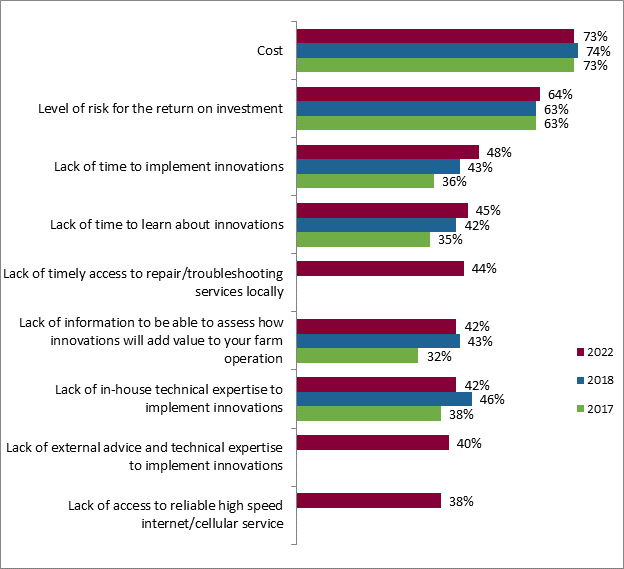
Q62: How much of a barrier is each of the following in terms of adopting new technologies and farm practices? Base: All respondents (n=1,447)
| 2022 | 2018 | 2017 | |
|---|---|---|---|
| Cost | 73% | 74% | 73% |
| Level of risk for the return on investment | 64% | 63% | 63% |
| Lack of time to implement innovations | 48% | 43% | 36% |
| Lack of time to learn about innovations | 45% | 42% | 35% |
| Lack of timely access to repair/troubleshooting services locally | 44% | no data | no data |
| Lack of information to be able to assess how innovations will add value to your farm operation | 42% | 43% | 32% |
| Lack of in-house technical expertise to implement innovations | 42% | 46% | 38% |
| Lack of external advice and technical expertise to implement innovations | 40% | no data | no data |
| Lack of access to reliable high speed internet/cellular service | 38% | no data | no data |
The following subgroups were especially likely to think that the cost is a barrier to adopting new technologies and farm practices:
The following subgroups were especially likely to think that the level of risk for the return on investment is a barrier to adopting new technologies and farm practices:
The following subgroups were especially likely to think that the lack of time to implement innovations is a barrier to adopting new technologies and farm practices:
The following subgroups were especially likely to think that the lack of time to learn about new innovations is a barrier to adopting new technologies and farm practices:
The following subgroups were especially likely to think that the lack of timely access to repair/troubleshooting services locally is a barrier to adopting new technologies and farm practices:
The following subgroups were likely to think that the lack of information to be able to assess how innovations will add value to their farm is a barrier to adopting new technologies and farm practices:
No significant differences were found between groups when it came to the lack of in-house technical expertise to implement innovations as a barrier to adopting new technologies and farm practices.
The following subgroups were especially likely to think that the lack of external advice and technical expertise is a barrier to adopting new technologies and farm practices:
The following subgroups were especially likely to think that the lack of access to reliable high-speed internet/cellular service is a barrier to adopting new technologies and farm practices:
Producers seem to need strong support in order to encourage them to adopt new technologies and practices, as each suggested measure was supported by over half of respondents. Financial assistance was needed by over six respondents out of ten (64%), while the opportunity to see technology in action was sought after by 59% of producers. In order to adopt new technologies and practices, producers also needed technical advice (55%), time to research and implement the new technology/practice (54%), and more information (52%).
As answer options are different from the 2018 study, comparison is presented for information purposes only.
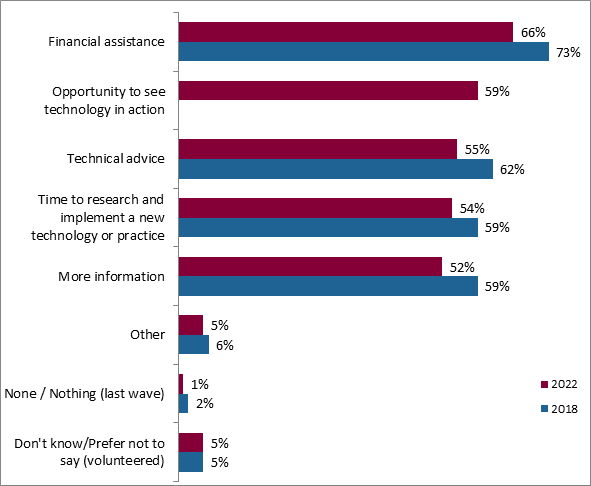
Q76: What do you need most to help you make decisions about adopting new technology and farm practices? Base: All respondents (n=1,447)
*Respondents were able to give up to three answers, total mentions may exceed 100%.
| 2022 | 2018 | |
|---|---|---|
| Financial assistance | 66% | 73% |
| Opportunity to see technology in action | 59% | no data |
| Technical advice | 55% | 62% |
| Time to research and implement a new technology or practice | 54% | 59% |
| More information | 52% | 59% |
| Other | 5% | 6% |
| None / Nothing (last wave) | 1% | 2% |
| Don't know/Prefer not to say (volunteered) | 5% | 5% |
The following subgroups showed significant differences in terms of needs:
Almost all surveyed producers (99%) have implemented at least one measure, program, or practice to respond to changing consumer trends. In fact, the average number of implemented measures was 7.5.
The top three measures, programs and practices implemented by producers are environmental stewardship programs (67%), nutrient management plans (67%), and reduced pesticide use (66%). The least popular measures among producers were irrigation or water conservation plans (41%), and the participation in a sector/industry assurance program (38%).
There is no significant difference in terms of the number of implemented measures, compared to 2018. As additional answer options were inserted in 2022, most answer options have lower proportions than 2018. Comparison with 2018 is presented for information purposes only.
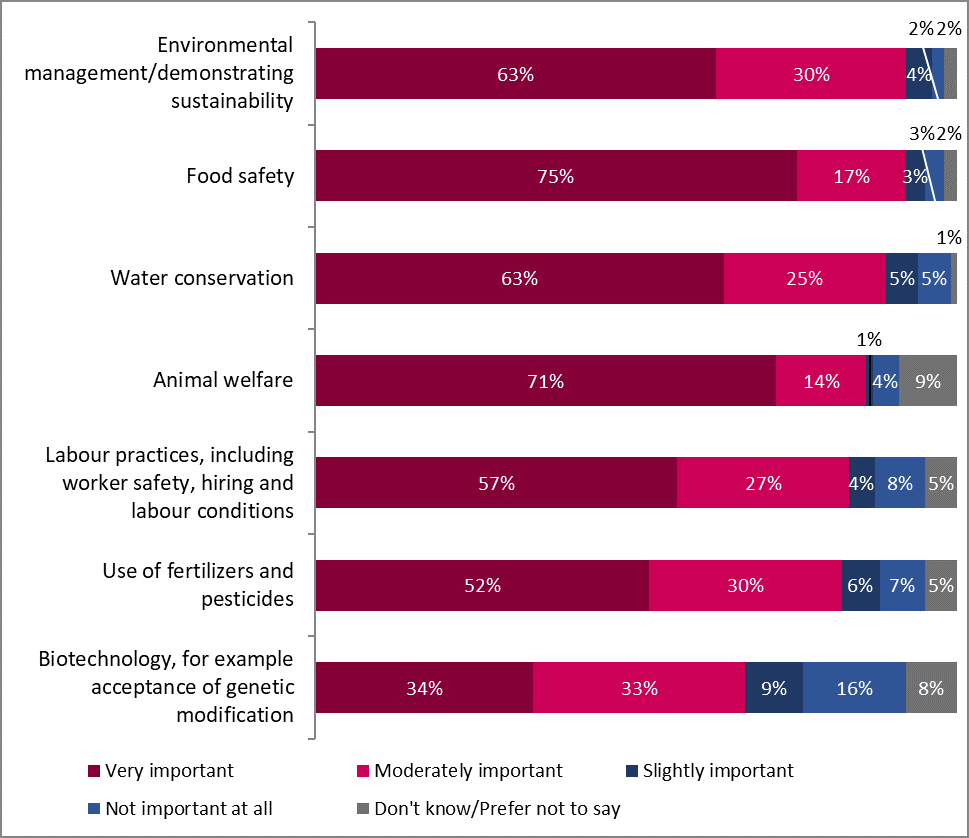
Q42: Which of the following measures, programs or practices have you implemented? If it is not applicable to your farm operation, please let me know. Base: All respondents (n=1,447)
*Respondents were able to give up to three answers, total mentions may exceed 100%.
| 2022 | 2018 | 2017 | |
|---|---|---|---|
| TOTAL At least one measure | 99% | 99% | 96% |
| Environmental stewardship programs | 67% | 71% | 63% |
| Nutrient management plan | 67% | 66% | 60% |
| Reduced pesticide use | 66% | 70% | 67% |
| Enhanced food safety measures | 60% | 68% | 59% |
| Humane animal welfare practices | 59% | 67% | 59% |
| Beneficial Manure handling | 54% | 60% | 52% |
| Using new technologies (e.g. precision agriculture) | 54% | 63% | no data |
| Publicly talking about how your farm operates | 53% | 60% | no data |
| Measures or practices to reduce/eliminate the use of drugs or antibiotics on farm animals | 48% | 55% | 47% |
| Actions to reduce human food waste | 44% | no data | no data |
| Irrigation or water conservation plan | 41% | 43% | 34% |
| Participation in a sector/industry assurance program | 38% | 37% | no data |
| Have not implemented any of these measures, programs or practices | 2% | 2% | 4% |
| None of these measures are applicable to the type of farm operation | 1% | 1% | 1% |
The following subgroups showed significant differences in the measures they implemented:
Only around one in ten (14%) producers considered that public perceptions about agriculture and food production have no impact whatsoever on their farming operations and decisions. Conversely, just over one producer in four (27%) think the impact is very low to low, and six producers out of ten (59%) considered that public perceptions have a significant impact on their operations.
In 2022, the impact of public perceptions on farm operations is perceived as less important than in 2018 and 2017 in (59% versus 67% for both 2018 and 2017). One hypothesis is this decline is related to the current focus on pandemic operations and recovery.
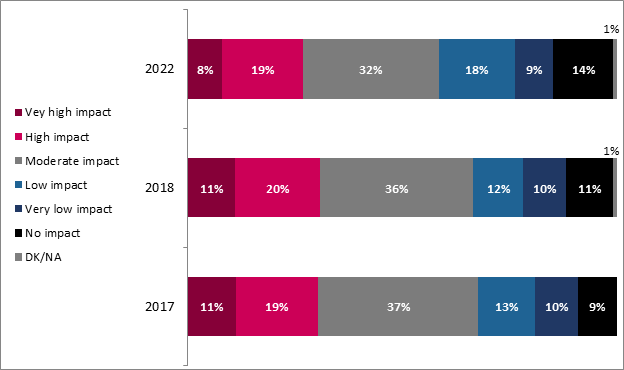
Q51: To what extent do public perceptions about agriculture and food production currently impact the way you operate your farm and the decisions you make? Base: All respondents (n=1,447)
| Vey high impact | High impact | Moderate impact | Low impact | Very low impact | No impact | DK/NA | |
|---|---|---|---|---|---|---|---|
| 2022 | 8% | 19% | 32% | 18% | 9% | 14% | 1% |
| 2018 | 11% | 20% | 36% | 12% | 10% | 11% | 1% |
| 2017 | 11% | 19% | 37% | 13% | 10% | 9% | 0% |
The following subgroups were especially likely to think that public perceptions about agriculture and food production currently impact the way they operate their farm and the decisions they make:
Among all seven prompted elements, three were considered important by around nine out of ten, and three others by around eight out of ten. Environmental sustainability (93%), food safety (92%) and water conservation (88%) came out at the top of the list, while biotechnology (67%) was last as it was considered important by around two thirds of the sample. Food safety and animal welfare stood out as the two items with the highest “Very important” proportion (75% and 71% respectively).
Some elements have lower importance rates by 5-6 significant points since 2018, even though producers did still consider them important. Comparison was based on the ‘Total important’ (Very important + Moderately important):
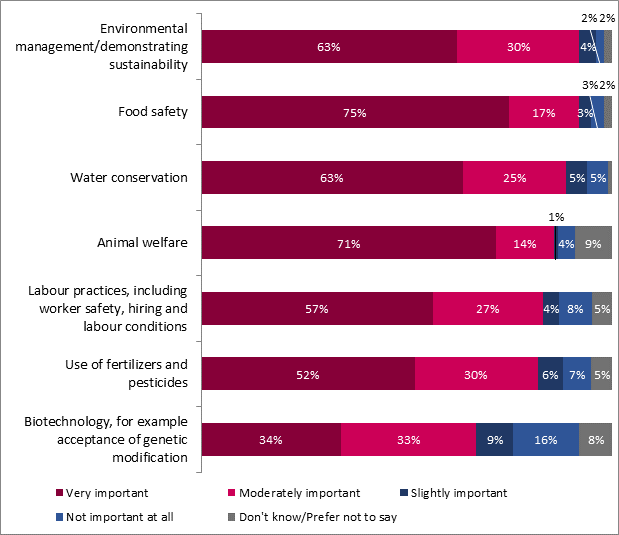
| Very important | Moderately important | Slightly important | Not important at all | Don't know/Prefer not to say | |
|---|---|---|---|---|---|
| Environmental management/demonstrating sustainability | 63% | 30% | 4% | 2% | 2% |
| Food safety | 75% | 17% | 3% | 3% | 2% |
| Water conservation | 63% | 25% | 5% | 5% | 1% |
| Animal welfare | 71% | 14% | 1% | 4% | 9% |
| Labour practices, including worker safety, hiring and labour conditions | 57% | 27% | 4% | 8% | 5% |
| Use of fertilizers and pesticides | 52% | 30% | 6% | 7% | 5% |
| Biotechnology, for example acceptance of genetic modification | 34% | 33% | 9% | 16% | 8% |

Q53: In your view, how important, if at all, are each of the following in terms of building or maintaining the public’s trust in agriculture? Base: All respondents (n=1,447)
| 2022 | 2018 | |
|---|---|---|
| Environmental management/demonstrating sustainability | 92% | 91% |
| Food safety | 92% | 96% |
| Water conservation | 89% | 90% |
| Animal welfare | 86% | 92% |
| Labour practices, including worker safety, hiring and labour conditions | 83% | 82% |
| Use of fertilizers and pesticides | 82% | 86% |
| Biotechnology, for example acceptance of genetic modification | 67% | 72% |
The following subgroups were especially likely to think environmental management is important to build and maintain the public’s trust in agriculture:
The following subgroups were especially likely to think food safety is important to build and maintain the public’s trust in agriculture:
The following subgroups were especially likely to think water conservation is important to build and maintain the public’s trust in agriculture:
The following subgroups were especially likely to think animal welfare is important to build and maintain the public’s trust in agriculture:
The following subgroups were especially likely to think labour practices are important to build and maintain the public’s trust in agriculture:
The following subgroups were especially likely to think the use of fertilizers and pesticides is important to build and maintain the public’s trust in agriculture:
The following subgroups were especially likely to think biotechnology is important to build and maintain the public’s trust in agriculture:
Overall, around half (47%) of producers have a formal environmental farm plan in place while the other half (49%) have stated they have no environmental farm plan.
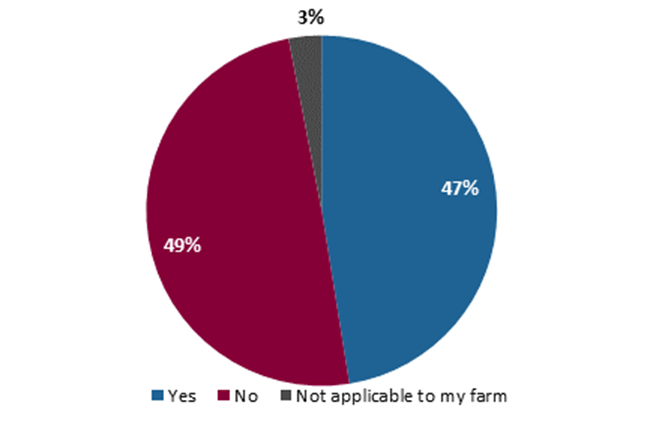
NQ19: Does your farm have a formal, written environmental farm plan? Base: All respondents (n=1,447)
| Total | |
|---|---|
| Yes | 47% |
| No | 49% |
| Not applicable to my farm | 3% |
The following subgroups were especially likely to have a formal written environmental farm plan:
Regardless of the production type, around one in ten (11%) farming operations were organic certified (9%) or in the process of getting the certification (2%). The certification is more common among poultry (20%), vegetable (24%) and fruit (21%) farming operations.
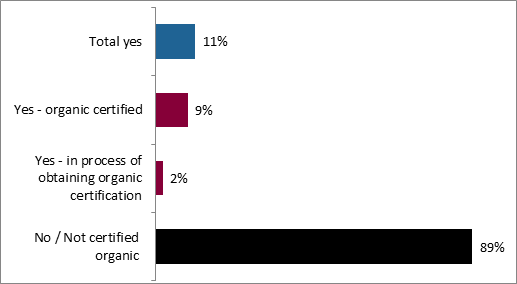
NQ24: Is your farm organic certified or in the process of receiving organic certification? Base: All respondents (n=1,447)
* No comparison with previous waves can be made as this is a new question.
| Total | |
|---|---|
| Total yes | 11% |
| Yes - organic certified | 9% |
| Yes - in process of obtaining organic certification | 2% |
| No / Not certified organic | 89% |
The following subgroups were more likely to be certified organic or in the process of obtaining the certification:
Around two producers out of three (69%) think that agricultural activities have a positive impact on the environment. Less than one in five (15%) think that they have a negative impact on the environment. The overwhelming positive opinion about the impact of agriculture on the environment may be linked to the increasing number of environmental sustainability measures put in place.
Compared to 2011, a significantly higher proportion of producers believes that agricultural activities have a positive impact on the environment (69% versus 58%).

NQ20: In general, do you believe that agricultural activities have… on the environment? Base: All respondents (n=1,447)
| 2022 | 2011 | 2009 | |
|---|---|---|---|
| A positive impact | 69% | 58% | 59% |
| A negative impact | 15% | 22% | 22% |
| No impact at all | 9% | 14% | 17% |
| Don’t know/Prefer not to say | 7% | 7% | 3% |
The following subgroups were more likely to think agricultural activities have a positive impact on the environment:
Environmental sustainability concerns seem to be at the forefront of agricultural practices: half of producers (50%) considered them a high priority, and four out of ten (41%) producers considered them a medium priority. Only about one producer out of ten (9%) considered them low priority.
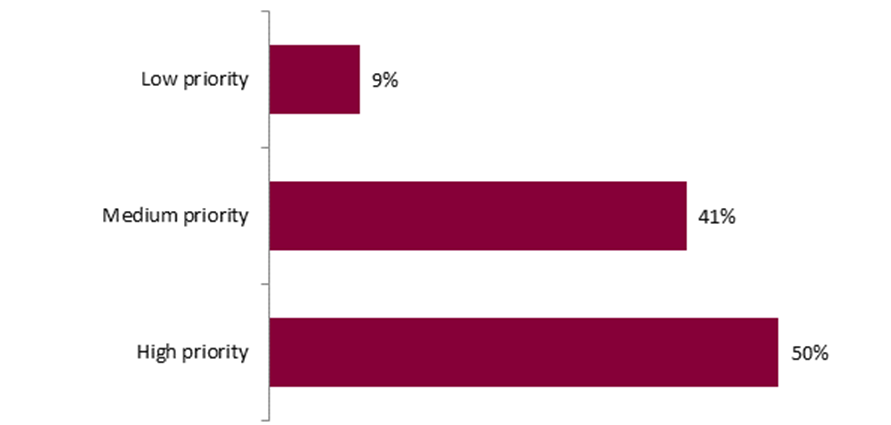
NQ21: How much of a priority is it for you to implement environmental sustainability initiatives? Base: All respondents (n=1,447)
| Total | |
|---|---|
| Low priority | 9% |
| Medium priority | 41% |
| High priority | 50% |
The following subgroups were significantly more likely to think of sustainability as a high priority:
Overall, almost all producers (98%) have implemented at least one environmental sustainability measure. Reduced pesticide use and crop rotations have been put in place by about three quarters (74%) of producers. Improving water quality and quantity was also implemented by more than two in three (67%) producers. The following measures were also implemented by at least six out ten producers: improving carbon storage in healthy soils (63%), zero/low till systems (63%), reducing fertilizer use (62%), improving biodiversity (62%), planting cover crops (60%), and riparian management (60%).
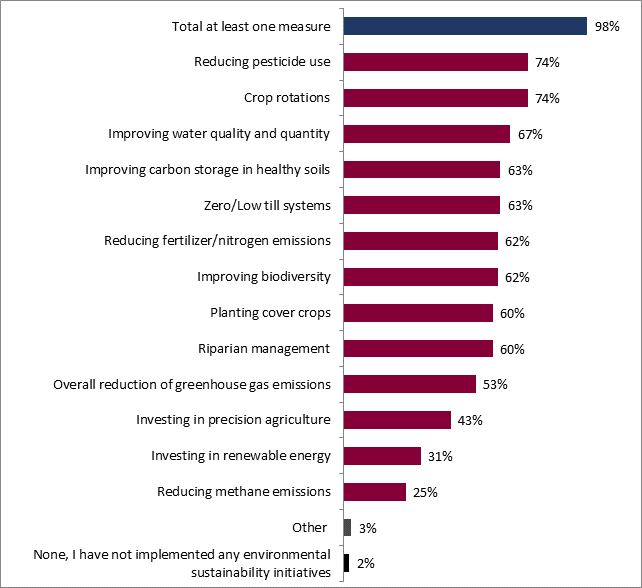
NQ23: Which of the following environmental sustainability measures, programs or practices have you implemented on your farm, if any?
Base: All respondents (n=1,447)
*Respondents were able to give up to three answers, total mentions may exceed 100%.
| Total | |
|---|---|
| Total at least one measure | 98% |
| Reducing pesticide use | 74% |
| Crop rotations | 74% |
| Improving water quality and quantity | 67% |
| Improving carbon storage in healthy soils | 63% |
| Zero/Low till systems | 63% |
| Reducing fertilizer/nitrogen emissions | 62% |
| Improving biodiversity | 62% |
| Planting cover crops | 60% |
| Riparian Management | 60% |
| Overall reduction of greenhouse gas emissions | 53% |
| Investing in precision agriculture | 43% |
| Investing in renewable energy | 31% |
| Reducing methane emissions | 25% |
| Other | 3% |
| NONE, I have not implemented any environmental sustainability initiatives | 2% |
Significant differences among subgroups include:
Overall, agricultural producers think their industry is doing its job in being sustainable and protecting the environment from the impact of their agricultural activities, as almost three out of four (73%) feel that producers are taking the appropriate actions to reduce their environmental impact.
The proportion of producers who consider that agricultural producers at large take the appropriate actions to minimize the impact of their activities on the environment has been consistently falling since 2009, dropping 15 points (88% in 2009 versus 73% in 2022). One hypothesis is that this could be due to the rising concern about climate change impacts, natural disasters and extreme weather events.

NQ25: Do you think agricultural producers are taking the appropriate actions to minimize the impact of their agricultural activities on the environment? Base: All respondents (n=1,447)
| 2022 | 2011 | 2009 | |
|---|---|---|---|
| Yes | 73% | 83% | 88% |
| No | 20% | 14% | 11% |
| Don’t Know/Prefer not to say (volunteered) | 7% | 3% | 1% |
The following subgroups were significantly more likely to think that agricultural producers are taking the appropriate actions to minimize the impact of their agricultural activities on the environment:
While overall, only around a third (35%) of producers declared having faced labour market challenges, strong differences exist among subgroups. High revenue producers (77% among farms with revenues over $5,000,000), as well as vegetable and fruit farming operations (69% and 63% respectively) were hit the hardest by labour market challenges.
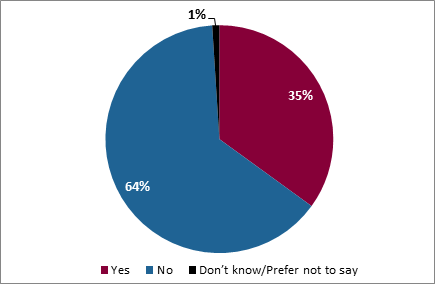
NQ26A: In the past 2 years, have you experienced any labour market challenges? (ex. Recruiting staff, training, etc.) Base: All respondents (n=1,447)
*No comparison with previous waves can be made as this is a new question.
| Total | |
|---|---|
| Yes | 35% |
| No | 64% |
| Don’t know/Prefer not to say | 1% |
The following subgroups were more likely to have experienced labour market challenges:
Among all types of labour market challenges, recruitment at large was encountered by over eight in ten producers who faced challenges (84%). Recruitment of staff in general, regardless of skill level, is an important challenge that producers had to face.
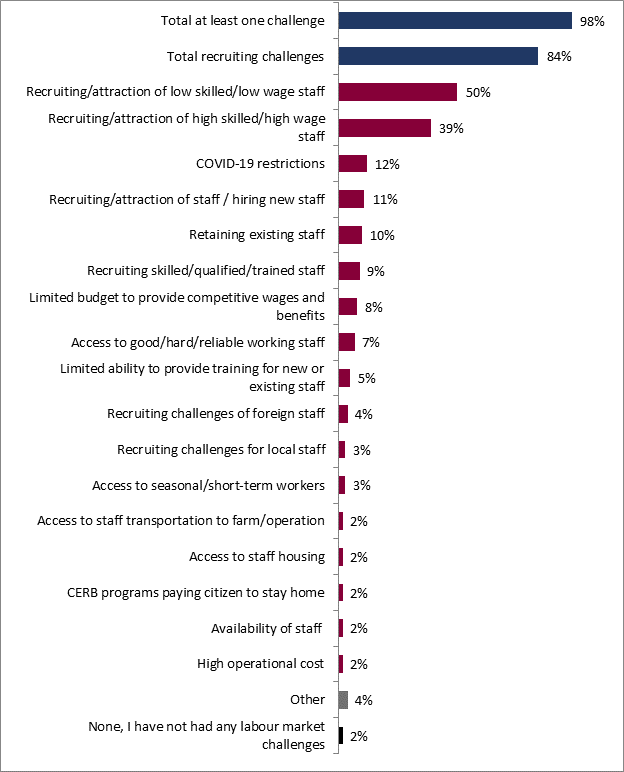
NQ26: What labour market challenges have you faced? Base: Respondents who faced labour market challenges (n=687)
*Because respondents were able to give up to three answers, total mentions may exceed 100%.
| Total | |
|---|---|
| Total at least one challenge | 98% |
| Total recruiting challenges | 84% |
| Recruiting/attraction of low skilled/low wage staff | 50% |
| Recruiting/attraction of high skilled/high wage staff | 39% |
| COVID-19 restrictions | 12% |
| Recruiting/attraction of staff / hiring new staff | 11% |
| Retaining existing staff | 10% |
| Recruiting skilled/qualified/trained staff | 9% |
| Limited budget to provide competitive wages and benefits | 8% |
| Access to good/hard/reliable working staff | 7% |
| Limited ability to provide training for new or existing staff | 5% |
| Recruiting challenges of foreign staff | 4% |
| Recruiting challenges for local staff | 3% |
| Access to seasonal/short-term workers | 3% |
| Access to staff transportation to farm/operation | 2% |
| Access to staff housing | 2% |
| CERB programs paying citizen to stay home | 2% |
| Availability of staff | 2% |
| High operational cost | 2% |
| Other | 4% |
| NONE, I have not had any labour market challenges | 2% |
Overall, finding staff with previous experience on farms (18%) and operating farming equipment/heavy machinery (16%) were the two most difficult skills and experience to find for farm producers who need staff. One producer out of three (33%) declared not having any paid staff or that the question was not applicable to their operation.

NQ27: When recruiting staff, what skills and experience are difficult to find, if any? Base: All respondents (n=1,447)
*Respondents were able to give up to three answers, total mentions may exceed 100%.
| Total | |
|---|---|
| On farm experience | 18% |
| Operating farming equipment/heavy machinery experience | 16% |
| Staff willing to work / serious / motivated | 8% |
| Knowledge of new/innovative technologies and farm practices | 5% |
| General experience / hands-on experience/knowledge | 4% |
| Technological experience | 3% |
| Good work ethic | 3% |
| Staff showing up/on time / attendance | 3% |
| Communication skills | 2% |
| Reliability | 2% |
| Physical endurance | 2% |
| Different class drivers | 2% |
| Animal handling/welfare | 2% |
| Common sense / basic skills | 2% |
| Availability to work (on weekend, longer hours, etc.) | 2% |
| Other | 2% |
| Not applicable/No paid staff | 33% |
| None, I have no issues hiring applicants that possess the required skills | 15% |
The following subgroups showed significant differences in terms of skills and experience challenges:
Around one in three (34%) agricultural producers have heard of the Canadian Agricultural Partnership. which was up by a significant 6 points from 2018 (28%).
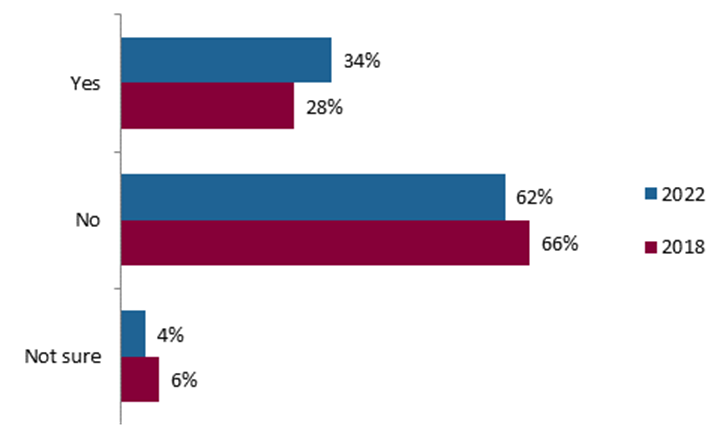
Q30: Have you seen, heard or read anything about the Canadian Agricultural Partnership? Base: All respondents (n=1,447)
| 2022 | 2018 | |
|---|---|---|
| Yes | 34% | 28% |
| No | 62% | 66% |
| Not sure | 4% | 6% |
The following subgroups were significantly more likely to know about the Canadian Agricultural Partnership:
The majority of producers who were aware of the Canadian Agricultural Partnership (59%) had a positive impression of the Canadian Agricultural Partnership, almost half (49%) of producers had a somewhat positive opinion of it, and almost one in ten (9%) had a very positive opinion of it. On the other hand, around one in five producers (22%) did not really have an opinion and saw it neither positively nor negatively. Less than a quarter (22%) of producers have expressed a negative perception of the Partnership.
The proportion of producers with a positive impression of the Canadian Agricultural Partnership has increased significantly since 2018 (up 10% from 49% in 2018).

Q32: What is your impression of the Canadian Agricultural Partnership? Base: Respondents who know the Canadian Agricultural Partnership (n=501)
| Very positive | Somewhat positive | Neither positive or negative | Somewhat negative | Very negative | DK/NA | |
|---|---|---|---|---|---|---|
| 2022 | 9% | 49% | 22% | 11% | 5% | 4% |
| 2018 | 10% | 39% | 20% | 14% | 11% | 6% |
The following subgroups were especially likely to have a positive opinion of the Canadian Agricultural Partnership:
On the other hand, producers from Quebec were less likely to have a positive impression of the Canadian Agriculture Partnership (34%).
Among those who were aware of the Canadian Agricultural Partnership, there were just as many producers who were familiar with programs and services available as those who were not, as a third of them (36%) were only slightly familiar, and over one in ten (15%) were not at all familiar with it.
Producers from Ontario and the Atlantic region (58% and 69% respectively) were more likely to be familiar with the programs and services available under the partnership, while those from Quebec (62%) were more likely to be unfamiliar with them (62%).
While the awareness (34% versus 28%) and appreciation (59% versus 49%) of the Canadian Agricultural Partnership have increased since 2018, the familiarity with its programs and services has not and remains at a similar level.

Q33: How familiar are you with programming and services available under the Canadian Agricultural Partnership? Base: Respondents who know the Canadian Agricultural Partnership (n=501)
| Very familiar | Somewhat familiar | Slightly familiar | Not at all familiar | DK/NA | |
|---|---|---|---|---|---|
| 2022 | 10% | 40% | 36% | 15% | 0% |
| 2018 | 13% | 34% | 35% | 17% | 1% |
When provided a definition and explanation of the program, over eight in ten producers (82%) agreed about the importance of the Canadian Agricultural Partnership investments.
The level of importance of these investments was also increasing since 2018, as one more person out of ten considers it important (total very + moderately important: 73% versus 82% respectively for 2018 and 2022).
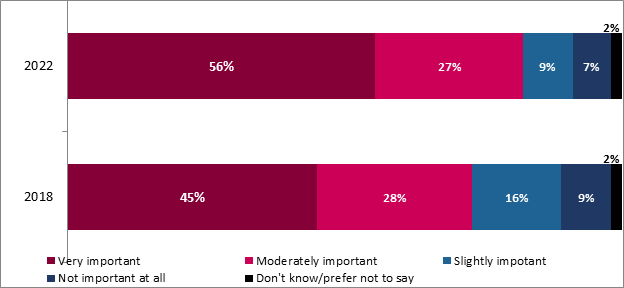
Q34: [As you may know], The Canadian Agricultural Partnership is a $3 billion five-year (2018-2023), investment by federal, provincial and territorial (FPT) governments to strengthen and grow Canada's agriculture and agri-food sector. The money is used to help farmers and the agricultural sector to grow trade and expand markets, support innovative and sustainable growth and support diversity in the sector. Given this information, how important, if at all, do you believe these investments are for the sector? Base: All respondents (n=1,447)
| Very important | Moderately important | Slightly impotant | Not important at all | Don't know/prefer not to say | |
|---|---|---|---|---|---|
| 2022 | 56% | 27% | 9% | 7% | 2% |
| 2018 | 45% | 28% | 16% | 9% | 2% |
The following subgroups were especially likely to think that the investments that were described are important for the sector:
When producers were asked to describe AAFC programs or services they have heard of, six in ten (59%) could not name a specific program. Of those that did know, the highest awareness was AgriStability (16%) and AgriInvest (14%). The next program, AgriInsurance, was known by half as many producers (7%) while awareness of other programs and services was even lower.

Q92: Which AAFC programs or services have you heard of? Base: All respondents (n=1,447)
*Respondents were able to give up to three answers, total mentions may exceed 100%.
| Total | |
|---|---|
| AgriStability | 16% |
| AgriInvest | 14% |
| AgriInsurance | 7% |
| Canadian Agriculture Loans Programs | 5% |
| AgriAssurance | 4% |
| Advance Payments Programs | 4% |
| AgriInnovate | 3% |
| AgriRisk | 3% |
| Agricultural Clean Technology Program | 3% |
| Crop insurance | 3% |
| Financial assistance / grant (others and unspecified) | 3% |
| AgriDiversity | 2% |
| AgriMarketing | 2% |
| AgriScience | 2% |
| Farm Debt Mediation Services | 2% |
| AgriRecovery | 2% |
| Other | 12% |
| None | 60% |
The following subgroups were especially likely to not know any of the AAFC programs or services:
Overall, the two most important priorities producers feel are important for governments to support are advancing agriculture science and research (92%), as well as promote trade and increase agriculture exports (87%). Respondents have given particular importance to these two support measures, as about two thirds of producers have considered them to be "very" important. Support for producer mental health initiatives came a close third with approval from over eight producers out of ten (84%). Addressing climate change was a priority for a little bit less than eight out of ten producers (78%), while supporting diversity and inclusivity in the industry was the last priority as it was supported by seven out of ten respondents (72%). All initiatives were however important to producers, as none of them had an importance rating lower than seven out of ten respondents.
Three of the priorities gained importance since 2018:
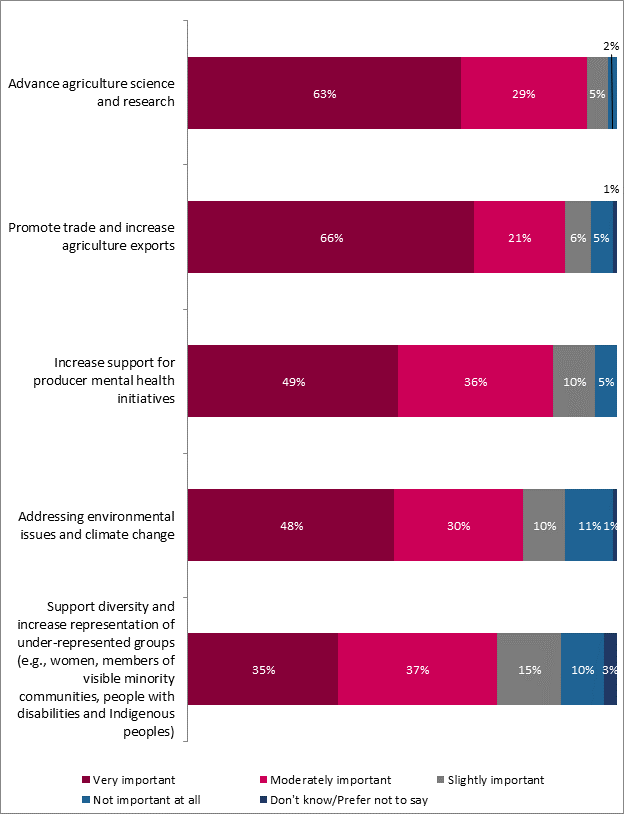
| Very important | Moderately important | Slightly important | Not important at all | Don't know/Prefer not to say | |
|---|---|---|---|---|---|
| Advance agriculture science and research | 63% | 29% | 5% | 2% | 0% |
| Promote trade and increase agriculture exports | 66% | 21% | 6% | 5% | 1% |
| Increase support for producer mental health initiatives | 49% | 36% | 10% | 5% | 0% |
| Addressing environmental issues and climate change | 48% | 30% | 10% | 11% | 1% |
| Support diversity and increase representation of under-represented groups | 35% | 37% | 15% | 10% | 3% |

Q40: How important, if at all, is it for the Government of Canada to support each of the following priorities. Base: All respondents (n=1,447)
| 2022 | 2018 | |
|---|---|---|
| Advance agriculture science and research | 92% | 85% |
| Promote trade and increase agriculture exports | 87% | 88% |
| Increase support for producer mental health initiatives | 84% | 78% |
| Addressing environmental issues and climate change | 78% | no data |
| Support diversity and increase representation of under-represented groups (e.g., women, members of visible minority communities, people with disabilities and Indigenous Peoples) | 72% | 63% |
The following subgroups were especially likely to think that it is important for the Government of Canada to advance agriculture science and research:
The following subgroups were especially likely to think that it is important for the Government of Canada to promote trade and increase agriculture exports:
The following subgroups were especially likely to think that it is important for the Government of Canada to increase support for producer mental health initiatives:
The following subgroups were especially likely to think that it is important for the Government of Canada to address environmental issues and climate change:
The following subgroups were especially likely to think that it is important for the Government of Canada to support diversity and increase representation of under-represented groups:
Few producers (11%) have subscribed to Agri-info in 2022, while close to nine in ten (89%) have not. Albertan producers (17%) were especially likely to have subscribed to Agri-info. As the question wording was changed from 2018, comparison with 2018 is presented for information purposes only.
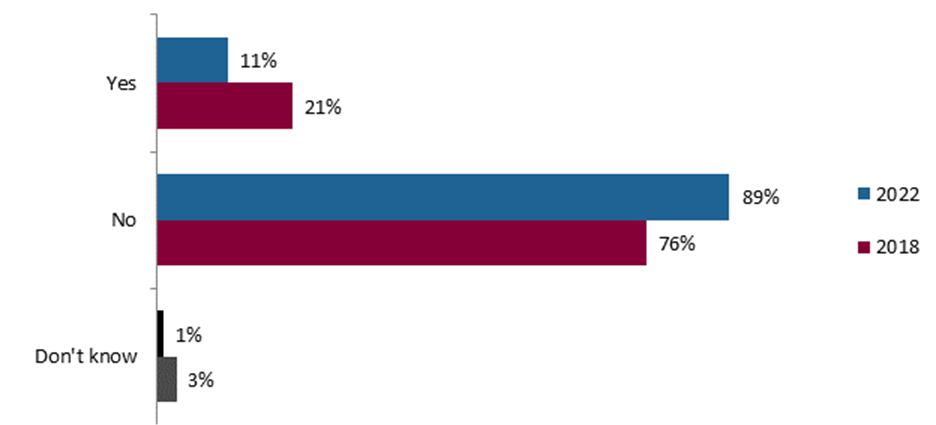
Q77: Do you subscribe to Agri-info, AAFC´s interactive web portal? Those who subscribe to Agri-info receive a newsletter featuring the new content every month. Base: All respondents (n=1,447)
| 2022 | 2018 | |
|---|---|---|
| Yes | 11% | 21% |
| No | 89% | 76% |
| Don't know | 1% | 3% |
Producers are overall less aware of AAFC social media channels than in 2018, as the proportion went down from one in four people to one in five (20%, down 6% from 2018), while eight in ten (80%) are not aware.
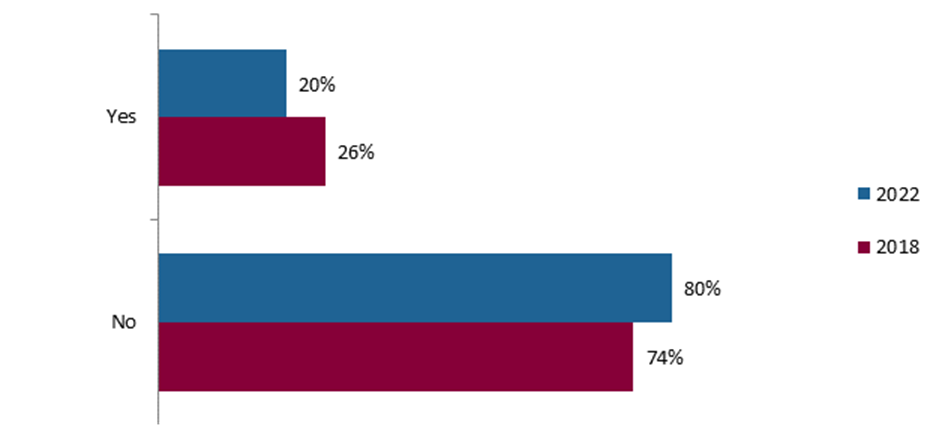
Q82: Are you aware of any of AAFC´s social media channels (e.g., LinkedIn, Facebook, Instagram, Twitter, YouTube?) Base: All respondents (n=1,447)
| 2022 | 2018 | |
|---|---|---|
| Yes | 20% | 26% |
| No | 80% | 74% |
The following subgroups were especially likely to be aware of AAFC’s social media channels:
More than half of producers would prefer to be informed about agricultural news and developments by email (53%) or mail (52%). Agri-info came in third, as it was preferred by around a third of producers (32% versus 44% in 2018). Other means, such as web portal, social media and podcasts, were preferred by one in five or fewer producers. In 2022, more producers preferred communication via email (53% up 3%) while AAFC website popularity has decreased since 2018 (21%, down from 34% in 2018) and social media’s popularity slightly increased (20% from 18% in 2018). Please note, a change in the wording to the “AAFC interactive web portal” from “AAFC website” may have impacted the results.
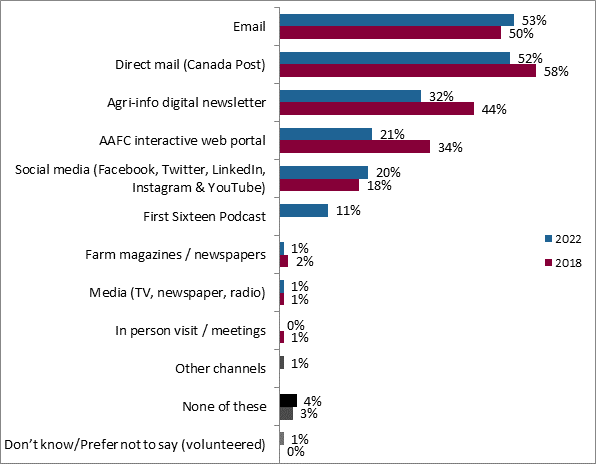
Q85: How would you prefer to be informed about the latest agricultural news and developments from AAFC? Base: All respondents (n=1,447)
*Respondents were able to give up to three answers, total mentions may exceed 100%.
| 2022 | 2018 | |
|---|---|---|
| 53% | 50% | |
| Direct mail (Canada Post) | 52% | 58% |
| Agri-info digital newsletter | 32% | 44% |
| AAFC interactive web portal | 21% | 34% |
| Social media (Facebook, Twitter, LinkedIn, Instagram & YouTube) | 20% | 18% |
| First Sixteen Podcast | 11% | no data |
| Farm magazines / newspapers | 1% | 2% |
| Media (TV, newspaper, radio) | 1% | 1% |
| In person visit / meetings | 0% | 1% |
| Other channels | 1% | no data |
| None of these | 4% | 3% |
| Don’t know/Prefer not to say (volunteered) | 1% | no data |
The following subgroups were especially likely to prefer being informed via email:
The following subgroups were especially likely to prefer being informed via direct mail:
The following subgroups were especially likely to prefer being informed via Agri-info:
Half of surveyed agricultural producers (50%) highly prioritize sustainability, and they show different attitudes than those who do not. They were more likely to identify climate change impacts as a key challenge (23%), but they also were more likely to think their farm operation would be better off in the future (41%).
Producers who prioritize sustainability initiatives also implemented more measures to mitigate emergency risks than their counterparts (7.6 versus 5.4) and were more likely to have an emergency management plan in place (46% versus 21% and 28% among those who give sustainability initiatives a low or medium priority respectively). Furthermore, a significantly higher proportion of them has an environmental farm plan in place (58% compared to 20% and 39% among low and medium priority respectively).
They were also more likely to recognize the importance of market diversification (92% versus 77% among those who give sustainability initiatives a low priority).
Public perceptions have a higher impact on their activities than average, as around seven in ten (69%) of them consider that public perceptions have a moderate to very high impact on the way they manage their farm. They were also more likely to think that environmental management (97%), food safety (94%), animal welfare (89%) and labour practices (91%) play a role in building and maintaining public trust.
Around six in ten (58%) have an environmental farm plan in place, compared to one in five among those who do not prioritize sustainability (20%).
And finally, they were more likely to view the Canadian Agriculture Partnership (CAP) investments as important (86% versus 58% among those who give a low priority to sustainability initiatives). They were also more likely to see investments in mental health initiatives as a priority (87% versus 69% among low priority), along with addressing climate change (87% versus 49%) and increasing efforts of diversity and representation (79% versus 49%).
Younger producers (who are aged 18 to 34 years old) were overall more optimistic towards the future of their farm operation (53% versus 30% among those 55 years old or older).
On the other hand, they were more likely to face diseases or pests (25% versus 11% among 55+), succession issues (19% versus 7%), profitability (15% versus 5%), and economic trends (11% versus 2%).
They were more likely to have implemented an emergency management plan (46% versus 34% among older producers), and they implemented some measures more than older subgroups: biosecurity measures (50% versus 34% among 55+ year-olds), simulation exercises (23% versus 15%), farm products diversification (72% versus 46% among 55+ year-olds) and financial planning (88% versus 70% among 55+ years old).
Regarding the adoption of new technologies and innovative processes, they were more likely to report needing financial assistance (77% versus 59% among 55+).
Being more concerned about environmental challenges, they highly prioritized sustainability (18-34: 59% versus 50% overall). This heightened attention to sustainability also explains why they were more likely to think agricultural activities have a positive impact on the environment (79% versus 69% overall). They were also more likely to be certified organic or in the process of obtaining the certification (22% versus 14% among 35-54 and 9% among 55+).
Young producers aged 18 to 34 years old faced their own set of labour challenges. They were more likely to have faced labour market challenges (57% versus 35% overall), especially when it came to recruiting high skilled staff (53% versus 39% overall) and retaining existing staff (21% versus 10% overall).
Female producers were overall more optimistic towards the future of their farm operation (42% versus 33% among men).
Being more concerned about environmental challenges, they highly prioritized sustainability (57% versus 48% overall). This heightened attention to sustainability also explains why they were more likely to think agricultural activities have a positive impact on the environment (79% and 73% respectively versus 69% overall), and why they were also more likely to report facing the impacts of climate change (53% versus 43% among men).
Female producers were more likely to think environmental management (96% versus 91%), animal welfare (92% versus 83%), food safety (96% versus 91%), and labour practices (88% versus 82%) are important to build and maintain the public's trust. Hence, they were more likely to have implemented humane animal welfare practices (72% versus 55%), beneficial manure handling (63% versus 50%), measures to reduce/eliminate the use of drugs or antibiotics on farm animals (56% versus 45%), irrigation or water conservation plan (51% versus 37%), publicly talking about how their farm operates (57%), and actions to reduce human food waste (54% versus 40%).
Female producers faced more barriers to adopting new technologies than men. Namely, cost (77% versus 71% among men), lack of time to implement innovations (54% versus 45%), lack of time to learn (51% versus 43%) and lack of external advice and technical expertise (48% versus 36%) were reported by a higher proportion of female producers compared to men. Consequently, they were more likely to report needing time to research and implement new technologies (64% versus 49%) and financial assistance (71% versus 61%).
Producers with a disability were mainly over 65 years old (55%) and male (81%). Around two in five had a cattle ranching and farming operation (40% versus 23%). Half of them had total farm sales between $25,000 and $100,000 (51%). Around half of all producers with disabilities stated their income has decreased in the last five years (47% versus 29%).
They were more likely to have implemented an emergency management plan (46% versus 33% among those who do not live with a disability).
They faced more barriers when it came to adopting new technologies: lack of access to reliable high speed internet/cellular service was considered a barrier by half of them (49% versus 37%), and cost and the level of risk for the return on investment were an extreme barrier for a higher proportion of producers with a disability (56% versus 42% and 35% versus 25% respectively).
Producers with disabilities were also more likely to believe that public perceptions had little to no impact on the way they operate their farm (50% versus 39%).
Finally, they were more likely to prefer being contacted by direct mail (63% versus 51%) rather than by email (43% versus 54%).
The seventh wave of the producers’ study has highlighted some continuing trends since previous editions, as well as brought to light new challenges that have arisen in the agri-food industry since 2018.
Overall, the sample has a similar distribution than previous waves. Farm revenue and regional distribution are similar to the 2018 wave. Significant differences include a slightly lower proportion of dairy cattle and farming, and poultry farming operations, and a slightly higher proportion of vegetable farming operations.
There is a range of expectations about the future of their farm operation, some producers were optimistic while others were concerned. Increasing production and input costs, along with climate change impacts, were at the forefront of producers’ concerns. They were also the two most commonly faced issues, followed by market price fluctuations and diseases or pests. To that effect, a third producers had an emergency management plan in place, but even those who did not have put in place several measures, financial planning and sustainable measures being the main ones.
Producers faced difficulties when it came to implementing technology due to several factors, namely the cost and the lack of time. Financial assistance and further training/education on the matter could bring a solution to the aforementioned issues. Labour market challenges were also encountered by a third of operations, as recruiting and retaining high skilled and low skilled staff is deemed difficult. On-farm experience and experience with farming equipment are the hardest skills to find in the labour market.
Public perceptions still play an important rule in agricultural operations management, and environmental initiatives and food safety, along with water conservation and animal welfare, are the most important drivers of public trust. Environmental sustainability is a hot topic in the agricultural industry, which is reflected in this research, as a majority of producers highly prioritize sustainable initiatives, while considering that farming activities have a positive impact on the environment. All producers have put in place some types of environmental measures, including reduced pesticide use, crop rotations, and water quality and quantity improvements. As a result, three in four respondents consider that agricultural producers are taking the right actions to minimize the impact of their activities on the environment.
Finally, awareness and appreciation of the Canadian Agricultural Partnership is on the rise, but familiarity with the services and programs offered remains constant. Top of mind awareness of the different programs and services offered under the Canadian Agricultural Partnership was also low. The majority of producers are not subscribed to Agri-Info or AAFC’s social media channels, so the best way to contact them is by email or direct mail. Promoting the new channels (including social media) could prove beneficial to find new, efficient ways to reach out to them. The investments of the Canadian Agriculture Partnership are viewed as important, and producers consider that the main priorities of the government investments should be advancing agriculture science and research and promoting trade and agricultural exports.
This study has faced several challenges, mainly in terms of data collection. Sample frame quality and the decline of landline phone popularity made it difficult to reach the target of 1,500 producers.
Further quantitative or qualitative studies focusing on the different issues that were unraveled through this survey could be beneficial in providing more in-depth insights into farm operations and the challenges they face. Namely, a deeper dive into the challenges associated with technology adoption, the labour market, and environmental and sustainable practices through in-depth interviews with producers could further enrich AAFC’s knowledge and provide a more nuanced portrait of the reality of agricultural producers across Canada.
Quantitative research was conducted through telephone surveys, using Computer Aided Telephone Interviewing (CATI) technology.
As a Canadian Research Insights Council Member, Leger adheres to the most stringent guidelines for quantitative research. The survey was conducted in accordance with Government of Canada requirements for quantitative research, including the Standards of the Conduct of Government of Canada Public Opinion Research—Series D—Quantitative Research.
Respondents were assured of the voluntary, confidential and anonymous nature of this research. As with all research conducted by Leger, all information that could allow for the identification of participants was removed from the data, in accordance with the Privacy Act.
The questionnaire is available in Appendix A2.
Leger was unable reach the target sample of 1,500 producers overall, as well as certain specific targets for some of the regions. These data collection challenges can be explained by several possible elements that made contacting agricultural producers difficult. First of all, the purchased list, while exhaustive, contained a significant portion of non-eligible respondents and no responses. Among the 29,995 contacted numbers, around 3,495 were non-eligible, corresponding to 11.7% of ineligible respondents in the sample. In addition to that, this year’s list was significantly shorter than that of 2018, with more invalid numbers. Another explanation can be drawn from the specific context during which data collection occurred namely the British Columbia flooding and wildfires that took place in 2021. These two environmental events had a significant impact on some producers and may explain why the BC target was not met.
Using data from the 2016 Canadian census of agriculture, the weighting was done by region and farm sales to ensure the best possible representation of the sample within each region and overall. The weight of each region was adjusted to be equivalent to its actual weight in relation to the distribution of the Canadian population.
A pre-test of 21 interviews was completed before launching data collection to validate the programming of the questionnaire in both English and French.
Computer Aided Telephone Interviewing (CATI)
A total of 1,447 respondents participated in the survey. The exact distribution is presented in the following section. Participant selection was done on a voluntary basis from the telephone list.
The sample source was purchased through Dynata and Canadian Viewpoint, who mainly draw their sample from Dun & Bradstreet data. Leger then managed any duplicates between the two list providers. As these lists are presumably exhaustive of all agricultural producers in the country, the sampling method used is probabilistic in nature. Considering a total population size of 373,940 agricultural producers in Canada, the margin of error for a 1,447 producers’ sample is ±2.571%, 19 times out of 20. Statistical differences between sub-groups or between waves are determined based on Z-test testing at 95% confidence.
Fieldwork for the survey was conducted from January 18th, 2022, to March 3rd, 2022. The participation rate for the survey was 38%. A pre-test of 21 interviews was completed between January 18th and January 24th, 2022. The average length of interview was 27 minutes and 42 seconds.
To achieve data reliability in all subgroups, a total sample of 1,447 Canadian farmers were surveyed, in all regions of the country.
Respondents for this survey were selected on a voluntary basis from a list of individuals working in the agricultural industry. As the list was exhaustive, the results of such a survey can be described as statistically projectable to the target population. To be eligible, respondents had to be at least 18 years old, live in Canada, be at least a joint decision-maker of their farming operation and have more than $10,000 in farm sales in 2021. The data have been weighted to reflect the demographic composition of the target population. The margin of error for a 1,447 producers’ sample is ±2.571%, 19 times out of 20.
Based on data from Statistics Canada’s 2016 Census of Agriculture, Leger weighted the results of this survey farm sales within each region of the country.
The following table details the regional distribution of respondents. The baseline sample attempted to replicate as closely as possible the actual distribution of the Canadian population.
| Region | Number of respondents |
|---|---|
| Atlantic | 100 |
| Quebec | 426 |
| Ontario | 285 |
| Prairies | 339 |
| Alberta | 195 |
| British Columbia | 102 |
| Total | 1,447 |
The overall participation rate for this study is 38%. Below is the calculation of the phone survey’s participation rate. The participation rate is calculated using the following formula: Participation rate = R ÷ (U + IS + R). The table below provides details of the calculation.
| Sample | Status | Number |
|---|---|---|
| Base sample | No service | 65 |
| Non-residential | 58 | |
| Fax / modem / pager | 335 | |
| Double | 30 | |
| Unresolved (U) | No answer | 681 |
| Answering machine | 2,508 | |
| Line busy | 0 | |
| Effective sample | In-scope non-responding units (IS) | 5,473 |
| Refusal | 5,305 | |
| Language Barrier | 168 | |
| Responding units (R) | Quota attained | 1 |
| Unqualified | 3,084 | |
| Incomplete | 182 | |
| Appointment | 609 | |
| Final results | Completed Interviews | 1,447 |
| Participation rate | 38% |
Note: The participation rate calculation has evolved since 2018. Namely, more elements are taken into account. Therefore, no comparison with 2018 can be drawn.
Typical participation rate for phone surveys is between 20% and 30%. While in 2018, around 22,000 numbers were contacted in order to reach the 1,500 respondents target, around 30,000 numbers were contacted for the 2022 survey. Around one in five producers were reached on a cellular phone (21%), and the rest on a landline phone. The above average participation rate of 38% may be explained by the fact that sampling of respondents was done through a specialized phone list including agricultural workers. In addition, extensive recontact, appointment setting and call back work was done to maximize the response rate for the entire sample base of producers. Several recalls (up to eight) were also made. The fact that landline phones are less and less popular among the general population but also among agricultural producers might also explain why data collection was harder this time around. For future editions of the study, exploring other options to contact agricultural producers could be beneficial and help reduce data collection challenges. A higher quality sample frame could also prove beneficial in targeting producers.
A basic comparison of the unweighted and weighted sample sizes was conducted to identify any potential non-response bias that could be introduced by lower response rates among specific demographic subgroups (see tables below).
The table below presents the geographic distribution of respondents, before and after weighting. The weighting adjusted for some discrepancies: the Atlantic region and Quebec weights were reduced in favour of Ontario, Alberta and British Columbia in order to have a sufficient subsample in these regions. Therefore, the weighting minimized the weight of these regions that had been inflated and slightly increased the weight of Ontario and Alberta.
| Region | Unweighted | Weighted |
|---|---|---|
| Atlantic | 100 | 56 |
| Quebec | 426 | 216 |
| Ontario | 285 | 371 |
| Prairies | 339 | 369 |
| Alberta | 195 | 304 |
| British Columbia | 102 | 131 |
| Total | 1,447 | 1,447 |
The following table presents the distribution of farm operations according to revenue level. The weighting decreased the weight of farm operations generating between $1,000,000 and $3,000,000 of revenue in favour of lower-revenue farm operations. The small differences observed have not introduced a non-response bias for either of these two sample subgroups.
| Region | Unweighted | Weighted |
|---|---|---|
| Less than $250,000 | 170 | 307 |
| $250,000 to just under $1,000,000 | 166 | 114 |
| $1,000,000 to just under $3,000,000 | 108 | 48 |
| $3,000,000 to just under $5,000,000 | 23 | 10 |
| $5,000,000 or more | 34 | 16 |
| Total | 1,447 | 1,447 |
There is no evidence from the data that having achieved a different region or revenue distribution prior to weighting would have significantly changed the results for this study. The relatively small weight factors (see section below) and differences in responses between various subgroups suggest that data quality was not affected. The weight that was applied corrected the initial imbalance for data analysis purposes and no further manipulations were necessary.
The following tables present the weighting factors applied to the database according to the different respondent profiles.
| Label | Equation | Weight |
|---|---|---|
| NL – Newfoundland and Labrador | PROV=NL | 0.2103% |
| PE – Prince Edward Island | PROV=PE | 0.6993% |
| NS – Nova Scotia | PROV=NS | 1.7975% |
| NB – New Brunswick | PROV=NB | 1.1654% |
| QC – Quebec | PROV=QC | 14.9458% |
| ON - Ontario | PROV=ON | 25.6341% |
| MB – Manitoba | PROV=MB | 7.6442% |
| SK – Saskatchewan | PROV=SK | 17.8421% |
| AB – Alberta | PROV=AB | 21.0024% |
| BC – British Columbia | PROV=BC | 9.0588% |
| Label | Equation | Weight |
|---|---|---|
| $10,000 to just under $25,000 | Q2=02 03 | 32.1% |
| $50,000 to just under $100,000 | Q2=04 | 15.1% |
| $100,000 to just under $250,000 | Q2=05,06,07 | 19.3% |
| $250,000 to just under $500,000 | Q2=08 | 13.7% |
| $500,000 or more | Q2=10,11,12,13,14,16 | 19.8% |
Sample distribution is very similar to previous waves. The majority of respondents were men and 55 years old or older. Some relevant significant differences with 2018 include:
| TOTAL 2022 (n=1,447) |
TOTAL 2018 (n=1,504) |
Statistically significant difference between years (Y) |
||
|---|---|---|---|---|
| Gender identity | Male | 71% | 72% | |
| Female | 29% | 28% | ||
| Age | 18-34 | 5% | 5% | |
| 35-44 | 11% | 7% | Y | |
| 45-54 | 17% | 16% | ||
| 55-64 | 29% | 37% | ||
| 65 + | 38% | 35% | ||
| Language | English | 85% | 85% | |
| French | 15% | 15% | ||
| Education | High school or less | 34% | 41% | Y |
| Trade/college | 34% | 30% | Y | |
| University | 31% | 29% | ||
| Racialized minority | Yes | 2% | no data | |
| No | 98% | no data | ||
| Racialized minority group (n= 32) |
South Asian (e.g., East Indian, Pakistani, Sri Lankan) | 19% | no data | |
| Chinese | 14% | no data | ||
| Black | 12% | no data | ||
| Filipino | 9% | no data | ||
| Latin American | 2% | no data | ||
| Korean | 2% | no data | ||
| Another group | 55% | no data | ||
| Indigenous persons | No, not an Indigenous person | 97% | 97% | |
| Yes, Métis | 2% | 1% | ||
| Yes, First Nations (North American Indian) | 0% | 2% | ||
| Yes, Inuk (Inuit) | 0% | 0% | ||
Tracking survey with Producers
Note to interviewers: Be proactive if you feel that respondents are not in a good environment (too much noise) or other good condition to answer the questionnaire. In these cases, schedule a telephone appointment to administer the survey.
Good morning/afternoon/evening. My name is _______________ and I am calling from Leger Marketing, a public opinion research company. Would you prefer that I continue in English or French? Préférez-vous que je continue en français ou en anglais?
We are conducting a study of agricultural producers on behalf of Agriculture and Agri-Food Canada about some important issues facing the farm sector across Canada. Your participation is voluntary and the survey will take about 20 minutes to complete. Please be assured that your identity and individual answers will be kept strictly confidential.
Note: If the respondent wants more information about the survey, read the following: The research is designed to provide AAFC with key insights into the views of producers on current issues in agriculture in Canada and on priorities and policies that affect the agriculture and agri-food sector in Canada.
Please select the language in which you wish to complete the survey.
RDD1. Have I reached you on a cellular phone? (Do not read list)
| Label | Value |
|---|---|
| Yes [if rdd1 = yes, ask, cell1] | 1 |
| No [if rdd1 = no, ask, cell2] | 2 |
CELL1. Are you in a safe place to talk on the telephone? (Do not read list)
| Label | Value |
|---|---|
| Yes | 1 |
| No | 2 |
INT91. [if cell1=no read:] We would like to conduct this interview with you when it is safe and convenient to do. Thank you for your time, we will call back when it is more convenient.
INT92. Is this a good time to call? (Do not read list)
| Label | Value |
|---|---|
| Yes [continue] | 1 |
| No [reschedule callback] | 2 |
Do not read - only if requested by the respondent: If the respondent requests to complete the survey via another mode, ask if they prefer to complete the survey on paper or via the Internet. Record the respondent's name, phone number, mailing address or email address so that we can conduct the interview with the respondent.
INT50. Before we begin the interview, I am required to inform you that for quality control reasons, this interview may be recorded. May we begin?
| Label | Value |
|---|---|
| Yes | 01 |
| No, refusal - thank and terminate | dr |
| Label | Value |
|---|---|
| Yes | 01 |
| No | 02 |
| Joint | 03 |
[If yes or joint, continue. If no, ask to speak to that person, read intro again. If unavailable, arrange callback. If no decision maker thank and terminate.]
Q2. For classification purposes, what were your total farm sales last year, that is, in 2021? Just stop me when I reach the correct category. [tracking, Q2] Total sales excluding any taxes they collected from customers (GST/PST/HST; we don’t want that included in sales).
[Do not read list – code open answer. If dk/na or “less than $10,000”, thank and terminate]
| Label | Value |
|---|---|
| Less than $10,000 | 01 |
| $10,000 to just under $25,000 | 02 |
| $25,000 to just under $50,000 | 03 |
| $50,000 to just under $100,000 | 04 |
| $100,000 to just under $150,000 | 05 |
| $150,000 to just under $200,000 | 06 |
| $200,000 to just under $250,000 | 07 |
| $250,000 to just under $500,000 | 08 |
| $500,000 to just under $1,000,000 | 10 |
| $1,000,000 to just under $2,000,000 | 11 |
| $2,000,000 to just under $3,000,000 | 12 |
| $3,000,000 to just under $4,000,000 | 13 |
| $4,000,000 to just under $5,000,000 | 14 |
| $5,000,000 or more | 16 |
| [do not read] don’t know/not applicable | 99 |
Q3. For classification purposes, in what year were you born? [if year born is more recent than 2003 thank and terminate] [tracking, Q3]
____________ record
Q4. Gender - [tracking, Q4]
record [not asked]
| Label | Value |
|---|---|
| Male | 01 |
| Female | 02 |
Q5. Language of interview [tracking, Q5]
[record]
| Label | Value |
|---|---|
| English | 01 |
| French | 02 |
Q6. Please provide your postal code (for analysis purposes only) [tracking, Q6]
___ ___ ___ ___ ___ ___
Main Questionnaire
Read:
Any information you provide will be administered in accordance with the Privacy Act and other applicable privacy laws. Your decision to participate or not will not affect any dealings you may have with the Government of Canada in any way.
NOTE: If a respondent asks you about the legitimacy of this project or if the respondent wants to make a complaint or a comment about this project, they may call 1-800-404-2464.
NOTE: If a respondent requests to speak with a study leader at Agriculture and Agri-Food Canada, please take his / her name and phone number and mention that a supervisor will call back to establish the link with Agriculture and Agri-Food Canada.
A. About your farm operation and use of business risk management tools
We’d like to know a bit more about your farm operation and how you manage risk to your business.
Q7. In 2021, what type of production contributed most to your gross farm revenue? [tracking, Q7]
[open end - accept only one response, do not read – pre-codes]
| Label | Value |
|---|---|
| Oilseed and grain farming (e.g. for example soybean, canola, flaxseed, mustard seed, safflower and sunflower, dried peas, dried beans, lentils, wheat, corn, rice, wild rice, buckwheat, wild rice, etc.) | 01 |
| Cattle ranching and farming (e.g. for example cow/calf, backgrounding, feedlot) | 02 |
| Dairy cattle and milk production | 03 |
| Beekeeping | 04 |
| Forage | 05 |
| Poultry farming | 06 |
| Pig farming | 07 |
| Vegetable farming | 08 |
| Fruit farming | 09 |
| OTHER types of farm production (for example greenhouse production, aquaculture, sheep and goat farming, etc.) specify: | 98 |
| Prefer not to say (volunteered) | 99 |
Q8.Looking ahead, what do think will be the single most important issue facing Canadian agriculture over the next 5 years? [TRACKING, Q8]
[do not read – code only one answer]
| Label | Value |
|---|---|
| Production costs / input costs | 01 |
| Commodity prices / variable prices | 02 |
| Profitability/viability of farming sector/making a living/returns covering costs | 03 |
| Trade/international trade barriers | 04 |
| Marketing/marketing boards/new markets | 05 |
| Fewer farm families/succession issues | 06 |
| Less farmland/farms closing | 07 |
| Labour shortages/availability/labour (general) | 08 |
| Farmers need more support/aid | 09 |
| Food labelling/legislation | 10 |
| Farm and food strategy | 11 |
| Climate change impacts/natural disasters and extreme weather fluctuations (for example floods, droughts, enough rain/moisture) | 12 |
| Supply management | 13 |
| Changing consumer demand | 14 |
| Carbon tax | 15 |
| Government intervention (policy, regulation, interference) | 36 |
| Public perceptions (trust, understanding) | 17 |
| Limits on herbicide, pesticide and fertilizer use | 18 |
| Other (specify ) | 96 |
| Not sure (volunteered) | 99 |
Q9. Looking ahead, how much better or worse off will your farm operation be in five years, compared to how it is now? [TRACKING, Q9]
[code one only]
| Label | Value |
|---|---|
| Much better | 01 |
| A little better off | 02 |
| A little worse off | 03 |
| Much worse off | 04 |
| I don’t expect any change in the next five years | 05 |
| Not sure (volunteered) | 09 |
Q10. What type of business risks does your farming operation face? [TRACKING, Q10M1-3]
[if required; prompt the respondent: Are there any others?]
[interviewer note: if required: Examples could be: access to markets, increased costs, diseases or pests, or weather fluctuations]
[do not read – code up to three]
| Label | Value |
|---|---|
| Diseases or pests (for example mad cow, crop blight) | 01 |
| Climate change impacts/natural disasters and extreme weather fluctuations (for example floods, droughts) | 02 |
| Market price fluctuations/volatility | 03 |
| Trade barriers/Barriers to market access | 04 |
| Other international factors (for example foreign subsidies, globalization) | 05 |
| Transportation or logistical challenges (for example difficulties moving products to market) | 06 |
| Exchange rates/fluctuations in the dollar | 07 |
| Changing government policies and programs | 08 |
| Food safety crisis/problems | 09 |
| Contamination (for example to ground water) | 10 |
| Increased operational/production/input costs (for example fuel, chemicals, fertilizers, labour costs) | 11 |
| Negative public perceptions/public trust (for example concerns about animal welfare) | 12 |
| Increased pressure from value-chain members (for example increased sustainability demands from retailers) | 13 |
| Taxes/Carbon Tax | 14 |
| Supply chain management | 15 |
| Interest rates | 16 |
| Profitability/Viability of Farming Sector/Making a Living/Returns Covering Costs | 22 |
| Fewer farm families/succession issues | 24 |
| Increasing competition | 20 |
| Marketing | 23 |
| Digitization | 30 |
| Cyber Risks | 31 |
| Land access/ability to expand | 34 |
| Discrimination (for example racism, sexism) | 35 |
| Finding feed for cattle | 26 |
| Other (specify) | 96 |
| Not sure (volunteered) | 99 |
Q12. What, if any, actions have you taken to manage or plan for the emergency risks that your farm operation may face? Have you implemented… If it is not applicable to your farm operation, please let me know. [TRACKING, Q11M1-13]
[read list and check all that apply]
| Label | Value |
|---|---|
| Biosecurity measures | 01 |
| Traceability system | 02 |
| Power generator | 03 |
| Stockpiled supplies | 04 |
| Simulation exercises to practice response activities | 05 |
| Emergency kit | 06 |
| Environment and/or sustainability measures | 07 |
| Animal welfare measures | 08 |
| Participation in a sector/industry assurance system (for example traceability) (last wave) | 09 |
| Participation in a business risk management program offered by federal and/or provincial/territorial governments (government support programs) | 10 |
| Participation in a private insurance program | 11 |
| Diversify farm products | 13 |
| Financial planning | 22 |
| Other (specify) | 96 |
| None | 99 |
Q13. Do you have an Emergency Management Plan in place for your farm operation? [TRACKING, Q12]
[interviewer note: Emergency Plan refers to the process of outlining procedures to take in an emergency and the roles and responsibilities for those that are involved.[
| Label | Value |
|---|---|
| Yes | 01 |
| No | 02 |
| No, but are in the process of making one | 03 |
| Prefer not to say (volunteered) | 99 |
Q24. How important, if at all, do you feel diversification of markets is for the growth of the Canadian agricultural sector? [tracking, Q17]
[code one response]
| Label | Value |
|---|---|
| Very important | 01 |
| Moderately important | 02 |
| Slightly important | 03 |
| Not important at all | 04 |
| Don’t know/Prefer not to say (volunteered) | 09 |
Now, we have a few questions about innovation in the agriculture and agri-food sector. Increasingly, farmers are adopting new technologies to enhance profitability, save time and protect the environment.
NQ62. How much of a barrier is each of the following in terms of adopting new technologies and farm practices? [tracking, Q44-Q49]
[randomize. read list].
ROW :
Label
COLUMN:
| Label | Value |
|---|---|
| Not a barrier | 01 |
| Somewhat of a barrier | 02 |
| Moderate barrier | 03 |
| Extreme barrier | 04 |
| Don’t know/Prefer not to say (volunteered) | 05 |
Q76. What do you need most to help you make decisions about adopting new technology and farm practices? [TRACKING, Q50M1-M5]
[read list and check all that apply].
| Label | Value |
|---|---|
| More information | 01 |
| Time to research and implement a new technology or practice | 02 |
| Technical advice | 03 |
| Financial assistance | 04 |
| Opportunity to see technology in action (for example at a demonstration or “Smart” farm) | 15 |
| Other (specify) | 96 |
| Don’t know/Prefer not to say (volunteered) | 99 |
In these next few questions we would like to understand the ways in which your farming operation may be responding to changing consumer trends.
Q42. Which of the following measures, programs or practices have you implemented? If it is not applicable to your farm operation, please let me know. [tracking, Q33M1-M11]
[randomize items 01-13. 98 and 99 should be anchored at end of list]
[read list and check all that apply. if asked, interviewer should clarify that these programs could have been ones implemented by the farm operator on their own, with a sector/industry association or with government.]
| Label | Value |
|---|---|
| Environmental stewardship programs | 01 |
| Humane animal welfare practices | 02 |
| Enhanced food safety measures | 03 |
| Actions to reduce human food waste | 15 |
| Reduced pesticide use | 04 |
| Irrigation or water conservation plan | 05 |
| Beneficial Manure handling | 06 |
| Nutrient management plan | 07 |
| Measures or practices to reduce/eliminate the use of drugs or antibiotics on farm animals | 08 |
| Participation in a sector/industry assurance program (if needed, read: Assurance systems enable the industry to make credible, meaningful and verifiable claims about its products and the manner in which they are produced.) | 09 |
| Publicly talking about how your farm operates | 10 |
| Using new technologies (for example: precision agriculture) | 11 |
| Have not implemented any of these measures, programs or practices | 12 |
| None of these measures are applicable to the type of farm operation you run (volunteered) | 99 |
Q51. To what extent do public perceptions about agriculture and food production currently impact the way you operate your farm and the decisions you make? [tracking, Q35]
[read responses]
| Label | Value |
|---|---|
| No impact | 01 |
| Very low impact | 02 |
| Low impact | 03 |
| Moderate impact | 04 |
| High impact | 05 |
| Very high impact | 06 |
| Don’t know/Prefer not to say (volunteered) | 09 |
Q53A. In your view, how important, if at all, are each of the following in terms of building or maintaining the public’s trust in agriculture? [TRACKING, Q36-Q43]
[randomize list]
Label
| Label | Value |
|---|---|
| Very important | 01 |
| Moderately important | 02 |
| Slightly important | 03 |
| Not important at all | 04 |
| Don’t know/Prefer not to say (volunteered) | 09 |
This section asks about environmental sustainability practices on your farm.
NQ19. Does your farm have a formal, written environmental farm plan?
| Label | Value |
|---|---|
| Yes | 01 |
| No | 02 |
| Not applicable to my farm | 03 |
| Don’t know / prefer not to say (volunteered) | 99 |
NQ20. In general, do you believe that agricultural activities have… on the environment?
[read list] [tracking, 2011/2009 question]
| Label | Value |
|---|---|
| A positive impact | 01 |
| A negative impact | 02 |
| No impact at all | 03 |
| Don’t know/Prefer not to say (volunteered) | 98 |
NQ21. How much of a priority is it for you to implement environmental sustainability initiatives?
[read list] [tracking, 2011/2009 question]
| Label | Value |
|---|---|
| Low Priority | 01 |
| Medium Priority | 02 |
| High Priority | 03 |
| Don’t know/Prefer not to say (volunteered) | 98 |
NQ23. Which of the following environmental sustainability measures, programs or practices have you implemented on your farm, if any? If it is not applicable to your farm operation, please let me know. Have you implemented.....
[read list - randomize – check all that apply]
| Label | Value |
|---|---|
| Overall reduction of greenhouse gas emissions | 01 |
| Reducing methane emissions | 02 |
| Reducing fertilizer/nitrogen emissions | 03 |
| Reducing pesticide use | 04 |
| Improving carbon storage in healthy soils | 05 |
| Investing in renewable energy | 06 |
| Investing in precision agriculture | 07 |
| Improving biodiversity | 08 |
| Improving water quality and quantity | 09 |
| Planting cover crops | 10 |
| Crop rotations | 11 |
| Zero/Low Till Systems | 12 |
| Riparian Management | 13 |
| Other (specify) | 96 |
| NONE, I have not implemented any environmental sustainability initiatives | 98 |
NQ24. Is your farm organic certified or in the process of receiving organic certification?
[code one response]
| Label | Value |
|---|---|
| Yes – organic certified | 01 |
| Yes – in process of obtaining organic certification | 02 |
| No / Not certified organic | 03 |
| Don’t Know/Prefer not to say | 04 |
NQ25. Do you think agricultural producers are taking the appropriate actions to minimize the impact of their agricultural activities on the environment?
[code one response]
| Label | Value |
|---|---|
| Yes | 01 |
| No | 02 |
| Don’t Know/Prefer not to say (volunteered) | 98 |
The next few questions are about labour market challenges that you may or may not be experiencing.
NQ26A. In the past 2 years, have you experienced any labour market challenges? (ex. Recruiting staff, training, etc.)
| Label | Value |
|---|---|
| Yes | 01 |
| No | 02 |
| I don’t know / I prefer not to answer | 99 |
[ask if Q26A=1]
[do not read list, code up to three answers]
| Label | Value |
|---|---|
| Recruiting/attraction of low skilled/low wage staff | 01 |
| Recruiting/attraction of high skilled/high wage staff | 02 |
| Limited ability to provide training for new or existing staff | 03 |
| Access to staff transportation to farm/operation | 04 |
| Access to staff housing | 05 |
| Retaining existing staff | 06 |
| Limited budget to provide competitive wages and benefits | 07 |
| Covid-19 restrictions | 08 |
| Other (Specify) | 96 |
| NONE, I have not had any labour market challenges | 98 |
NQ27. When recruiting staff, what skills and experience are difficult to find, if any?
[do not read list – code up to three]
| Label | Value |
|---|---|
| Operating farming equipment/heavy machinery experience | 01 |
| Technological experience | 02 |
| Leadership experience | 03 |
| On farm experience | 04 |
| Veterinary expertise | 05 |
| Knowledge of new/innovative technologies and farm practices | 06 |
| University education | 07 |
| Communication skills | 08 |
| Other (specify) | 96 |
| NONE, I have no issues hiring applicants that possess the required skills | 98 |
This section asks about Agriculture and Agri-Food Canada (AAFC) initiatives.
Q30. Have you seen, heard or read anything about the Canadian Agricultural Partnership? [tracking, Q18]
| Label | Value |
|---|---|
| Yes | 01 |
| No | 02 |
| Not sure | 09 |
Q32. What is your impression of the Canadian Agricultural Partnership? [TRACKING, Q20]
| Label | Value |
|---|---|
| Very positive | 01 |
| Somewhat positive | 02 |
| Neither positive or negative | 03 |
| Somewhat negative | 04 |
| Very negative | 05 |
| Don’t know/Prefer not to say (volunteered) | 09 |
Q33. How familiar are you with programming and services available under the Canadian Agricultural Partnership? [TRACKING, Q21]
| Label | Value |
|---|---|
| Very familiar | 01 |
| Somewhat familiar | 02 |
| Slightly familiar | 03 |
| Not at all familiar | 04 |
| Don’t know/Prefer not to say (volunteered) | 09 |
Q34. [read to all, but if yes to Q25 add: “As you may know”] The Canadian Agricultural Partnership is a $3 billion five-year (2018-2023), investment by federal, provincial and territorial (FPT) governments to strengthen and grow Canada's agriculture and agri-food sector. The money is used to help farmers and the agricultural sector to grow trade and expand markets, support innovative and sustainable growth and support diversity in the sector.
Given this information, how important, if at all, do you believe these investments are for the sector? [tracking, Q22]
| Label | Value |
|---|---|
| Very important | 01 |
| Moderately important | 02 |
| Slightly important | 03 |
| Not important at all | 04 |
| Don’t know/Prefer not to say (volunteered) | 09 |
Q92. Which AAFC programs or services have you heard of? [tracking, Q61M1-13]
[do not read – pre-codes – check all that apply]
| Label | Value |
|---|---|
| AgriAssurance | 01 |
| AgriCompetitiveness | 02 |
| AgriDiversity | 03 |
| AgriInnovate | 04 |
| AgriMarketing | 05 |
| AgriRisk | 06 |
| AgriScience | 07 |
| Advance Payments Programs | 08 |
| AgriInvest | 09 |
| AgriStability | 10 |
| AgriInsurance | 11 |
| Farm Debt Mediation Services | 12 |
| Agricultural Climate Solutions - Living Laboratories Initiative | 13 |
| Agricultural Climate Solutions – On Farm Climate Action Fund | 14 |
| Agricultural Clean Technology Program | 15 |
| AgriCommunication | 16 |
| Canadian Agriculture Loans Programs | 17 |
| Other (specify) | 96 |
| None | 97 |
Q40. How important, if at all, is it for the Government of Canada to support each of the following priorities: [TRACKING, Q28-32]
[RANDOMIZE]
ROW :
| Label | Value |
|---|---|
| Promote trade and increase agriculture exports | |
| Advance agriculture science and research | |
| Support diversity and increase representation of under-represented groups (for example: women, members of visible minority communities, people with disabilities and Indigenous Peoples) | |
| Increase support for producer mental health initiatives | |
| Addressing environmental issues and climate change |
COLUMN :
| Label | Value |
|---|---|
| Very important | 01 |
| Moderately important | 02 |
| Slightly important | 03 |
| Not important at all | 04 |
| Don’t know/Prefer not to say (volunteered) | 09 |
The next few questions ask about your experience interacting and communicating with Agriculture and Agri-Food Canada (AAFC).
Q77. Do you subscribe to Agri-info, AAFC’s interactive web portal? Those who subscribe to Agri-info receive a newsletter featuring the new content every month? [TRACKING, Q51]
| Label | Value |
|---|---|
| Yes | 01 |
| No | 02 |
| Don’t know | 09 |
Q82. Are you aware of any of AAFC’s social media channels (e.g., LinkedIn, Facebook, Instagram, Twitter, YouTube?)
| Label | Value |
|---|---|
| Yes | 1 |
| No | 2 |
Q85. How would you prefer to be informed about the latest agricultural news and developments from AAFC? [tracking, Q51M1-M6]
[read list and check all that apply]
| Label | Value |
|---|---|
| Direct mail (Canada Post) | 01 |
| 02 | |
| Social media (Facebook, Twitter, LinkedIn, Instagram and YouTube) | 03 |
| AAFC interactive web portal | 04 |
| Agri-info digital newsletter | 05 |
| First Sixteen Podcast | 09 |
| None of these | 97 |
| Other channels (specify) | 96 |
| Don’t know/Prefer not to say (volunteered) | 99 |
Finally, these last few questions will help us analyse your responses.
Q86. How many years have you been managing a farm business? [TRACKING, Q55]
[record number of years]
| Label | Value |
|---|---|
| Less than five years | 01 |
| 5 to 9 years | 02 |
| 10 to 14 years | 03 |
| 15 to 19 years | 04 |
| 20 to 24 years | 05 |
| 25 to 29 years | 06 |
| 30 to 34 years | 07 |
| 35 to 39 years | 08 |
| 40 to 44 years | 09 |
| 45 to 49 years | 10 |
| 50 to 54 years | 11 |
| 55 to 59 years | 12 |
| 60 to 64 years | 13 |
| 65 years or more | 14 |
| Prefer not to say (volunteered) | 99 |
Q87. Focusing now on net farm business income after operating expenses, during the last five years, has the net income of your operation…? [TRACKING, Q56]
[read and randomly reverse order of 1 and 3]
| Label | Value |
|---|---|
| Increased | 01 |
| Stayed the same | 02 |
| Decreased | 03 |
| Prefer not to say (volunteered) | 09 |
Q89. Does your household receive off-farm income? [TRACKING, Q58]
[read if necessary – For example, do either you or your partner have a job off the farm that supplements your income from agricultural production?]
| Label | Value |
|---|---|
| Yes | 01 |
| No | 02 |
| Prefer not to say (volunteered) | 09 |
NQ40. What is your gender identity? [If you do not feel comfortable disclosing, you do not need to do so]
[do not read list, code one only]
| Label | Value |
|---|---|
| Man | 01 |
| Woman | 02 |
| Transgender man | 03 |
| Transgender woman | 04 |
| Non-Binary | 05 |
| Prefer to self describe, Specify | 96 |
| Prefer not to say | 99 |
Q88. What is the highest level of formal education that you have completed? [TRACKING, Q57]
[do not read – code one only]
| Label | Value |
|---|---|
| Elementary school | 01 |
| Some high school | 02 |
| Complete high school | 03 |
| Some community college/CEGEP | 04 |
| Complete community college/CEGEP | 05 |
| Some vocational/trade school/commercial/including Ag Diploma | 06 |
| Complete vocational/trade school/commercial/including Ag Diploma | 99 |
| Some university (no degree) | 08 |
| Complete university degree | 09 |
| Prefer not to say (volunteered) | 10 |
Q90. Do you consider yourself to be an Indigenous person, that is, First Nations (North American Indian), Métis or Inuk (Inuit)? [TRACKING, Q59]
[code one only]
| Label | Value |
|---|---|
| No, not an Indigenous person | 01 |
| Yes, First Nations (North American Indian) | 02 |
| Yes, Métis | 03 |
| Yes, Inuk (Inuit) | 04 |
| Prefer not to say (volunteered) | 09 |
[ask all]
NQ43. Now we have question about racialized minorities. A person in a racialized minority group in Canada is someone (other than an Indigenous person as asked above) who is non-Caucasian in race or non-white in colour, regardless of place of birth. Are you a member of a racialized minority group?
| Label | Value |
|---|---|
| Yes | 01 |
| No | 02 |
[ask if NQ43=yes]
NQ43A. if yes, of which ethno-cultural or visible minority group or groups are you a member? Are you...
| Label | Value |
|---|---|
| Chinese | 01 |
| Black | 02 |
| Filipino | 03 |
| Arab | 04 |
| Latin American | 05 |
| Southeast Asian (for example Vietnamese, Cambodian, Laotian, Thai) | 06 |
| South Asian (for example East Indian, Pakistani, Sri Lankan) | 10 |
| West Asian (for example Iranian, Afghan) | 07 |
| Korean | 08 |
| Japanese | 09 |
| Another group (Specify) | 96 |
NQ44. For this study, a person with a disability is a person who has a long-term or recurring impairment such as vision, hearing, mobility, flexibility, dexterity, pain, learning, developmental, memory or mental health-related impairments which limits their daily activities inside or outside the home such as at school, work, or in the community in general. Do you consider yourself to be a person with a disability?
| Label | Value |
|---|---|
| Yes | 01 |
| No | 02 |
| Prefer not to say (volunteered) | 99 |
Q93. (For respondents living outside Quebec or New Brunswick): Do you consider yourself to be a member of a Francophone minority community in your province or Territory? (if asked: A Francophone minority community refers to Francophones who are living in French-speaking communities outside of Quebec or New Brunswick).
(For respondents living in Quebec): Do you consider yourself to be a member of an Anglophone minority community? (if asked: An Anglophone minority community refers to Anglophones who are living in an English-speaking community in the province of Quebec). [tracking, Q62]
| Label | Value |
|---|---|
| Yes | 01 |
| No | 02 |
| Prefer not to say (volunteered) | 09 |
Thank you very much for your time and participation. The results of the research will be available to the general public, on the Library and Archives website, in the coming months.
Footnotes
The “(last wave)” mention refers to answer options that were present in the 2018 wave and came up in 2022 as open answers.